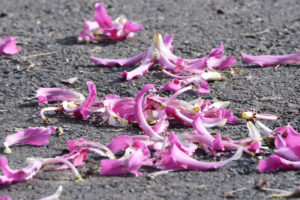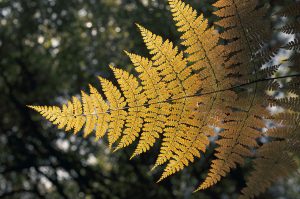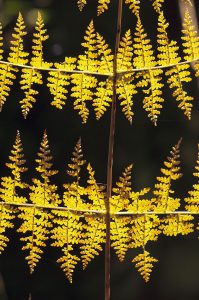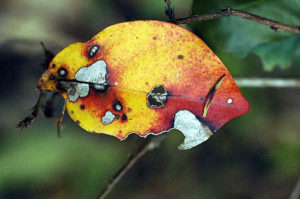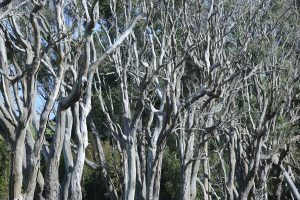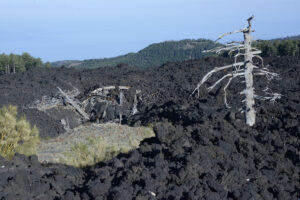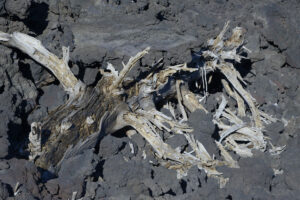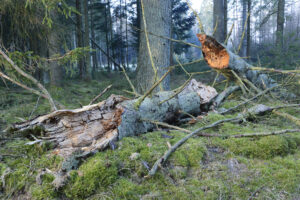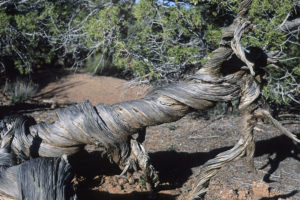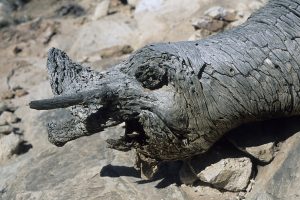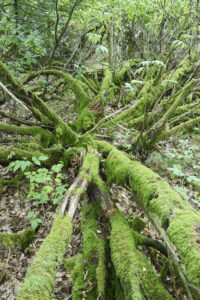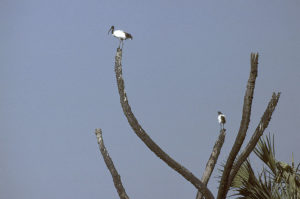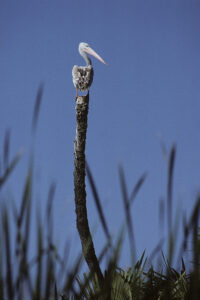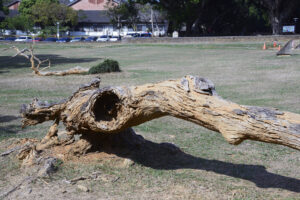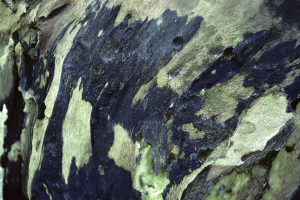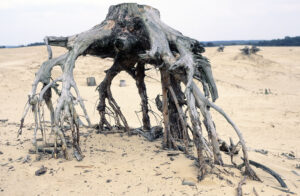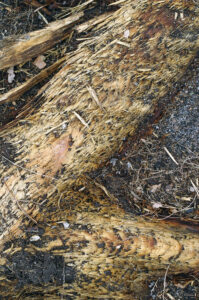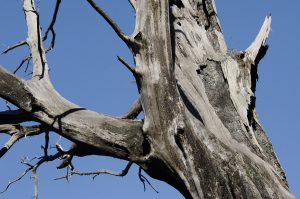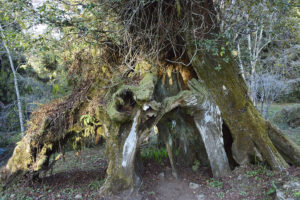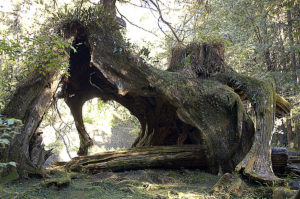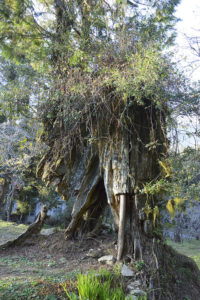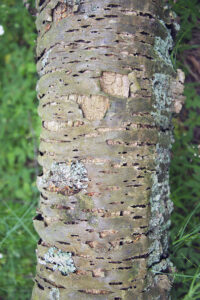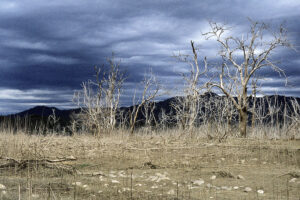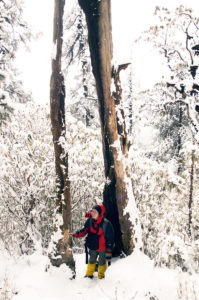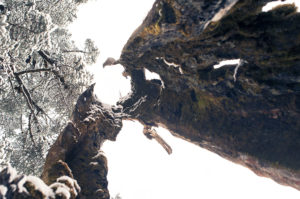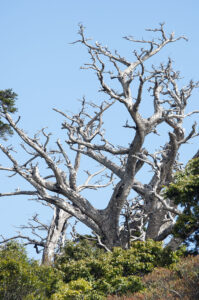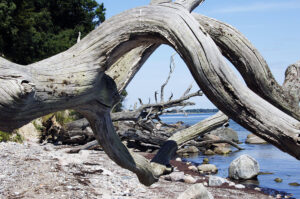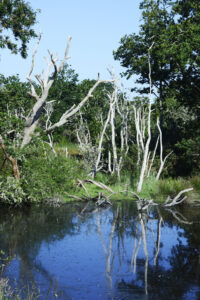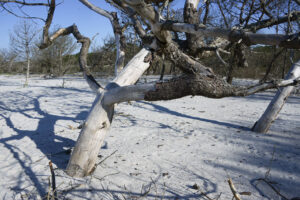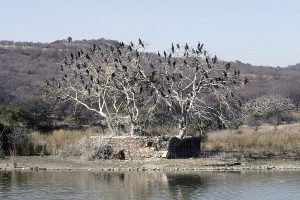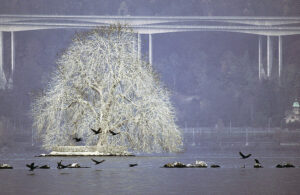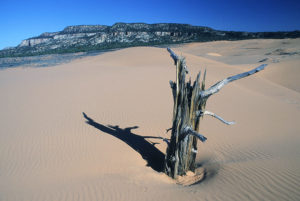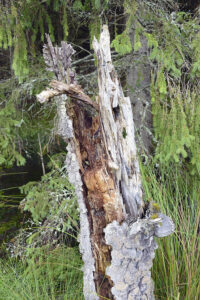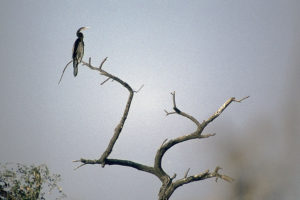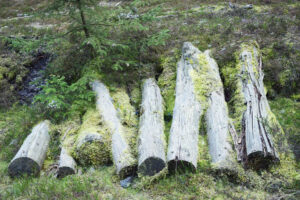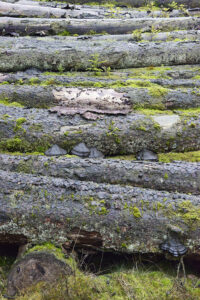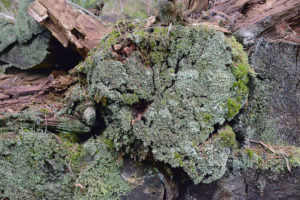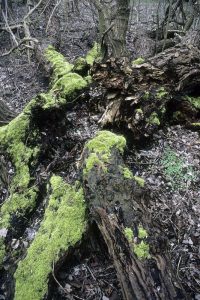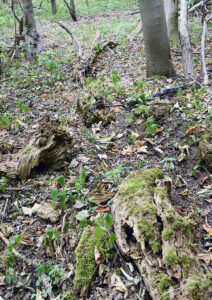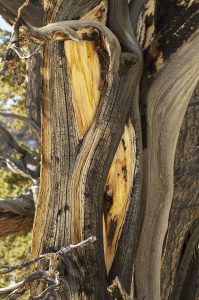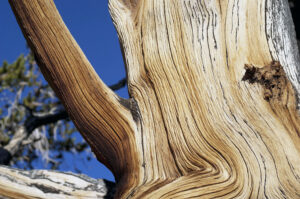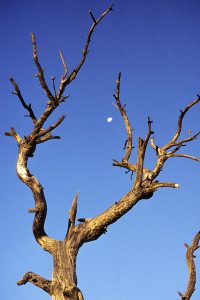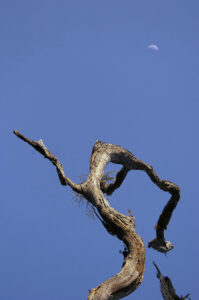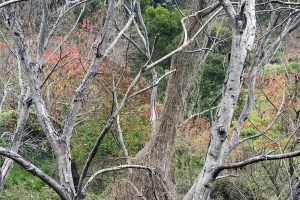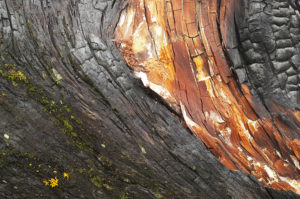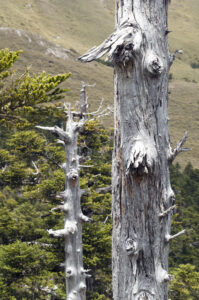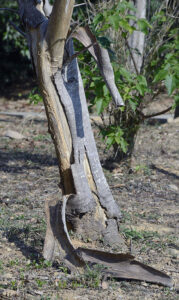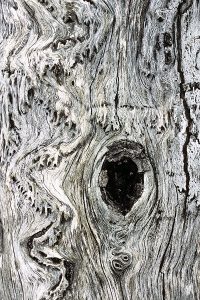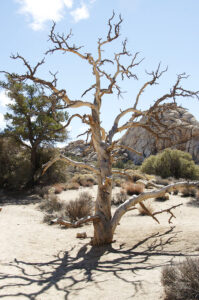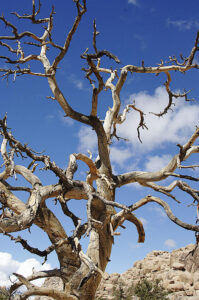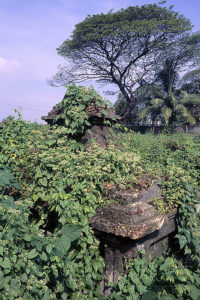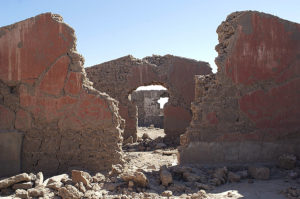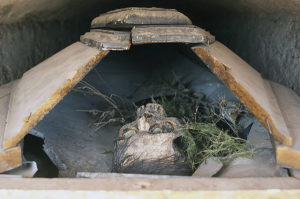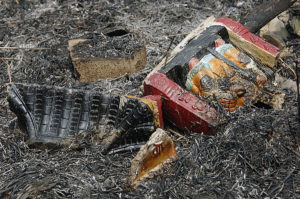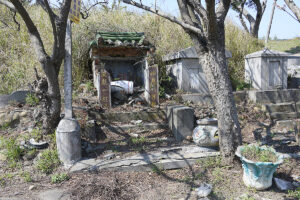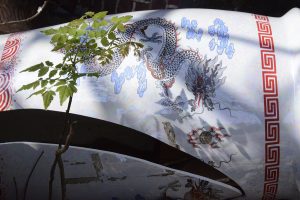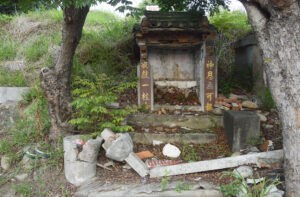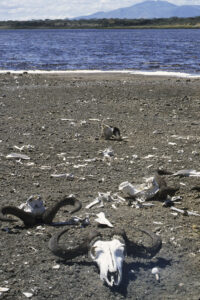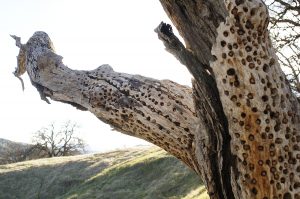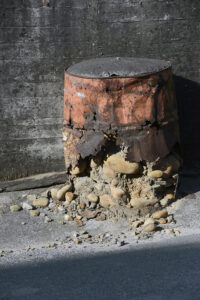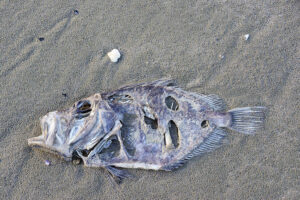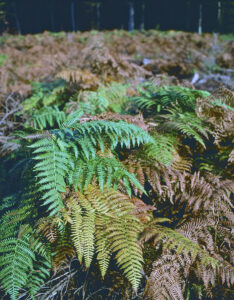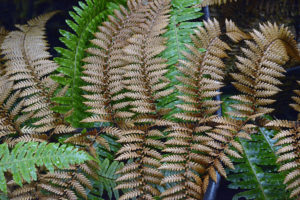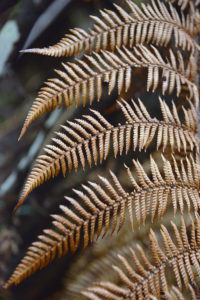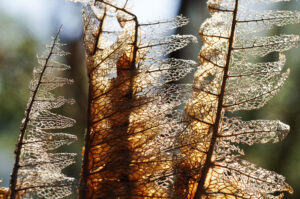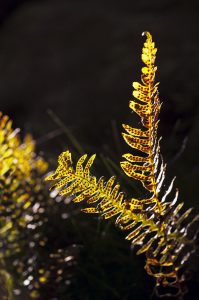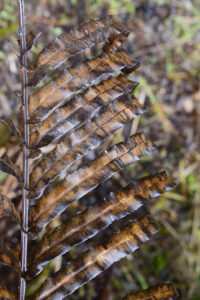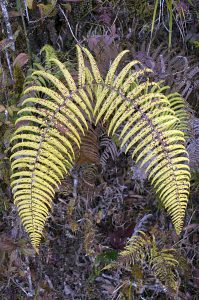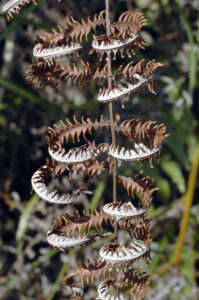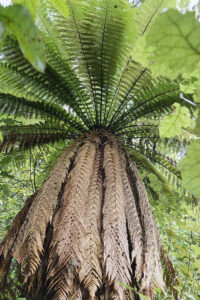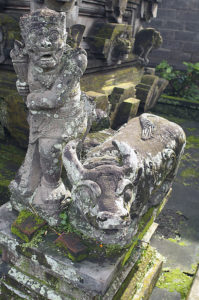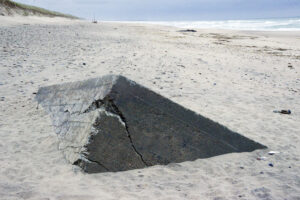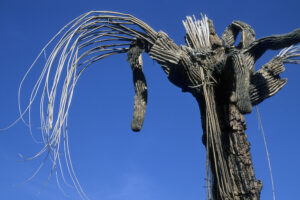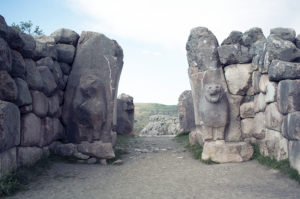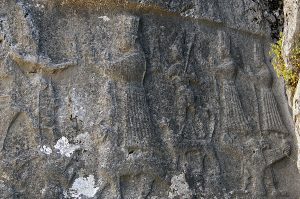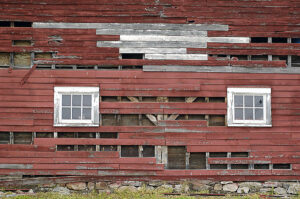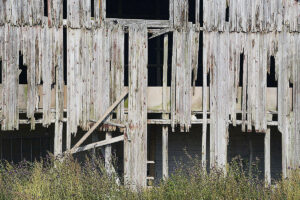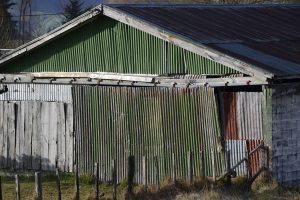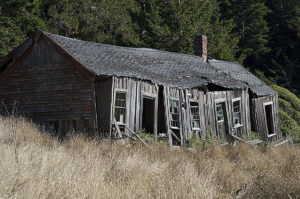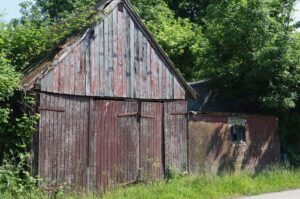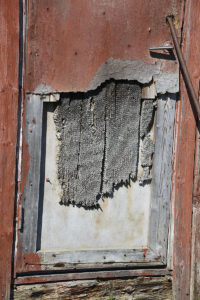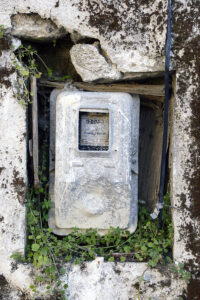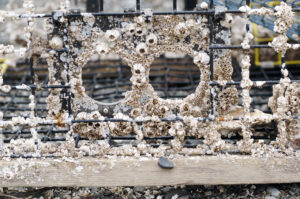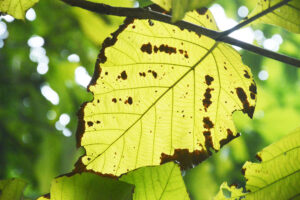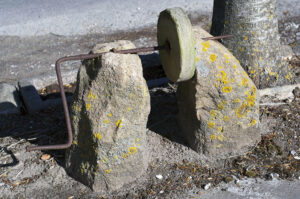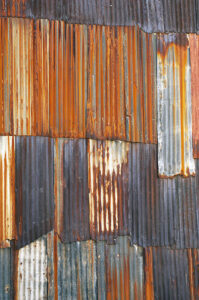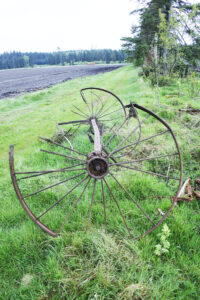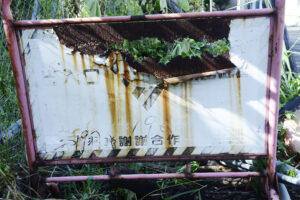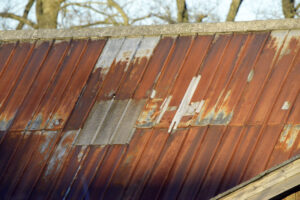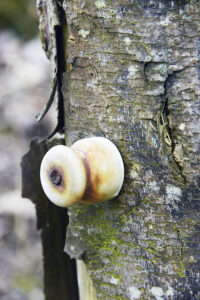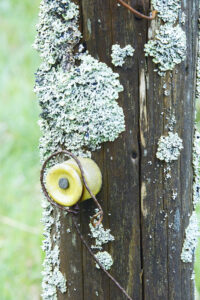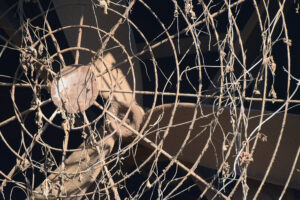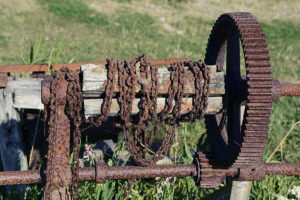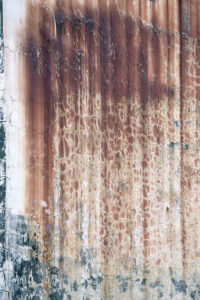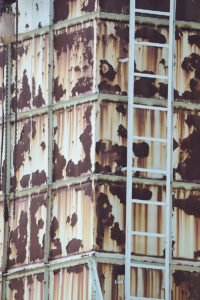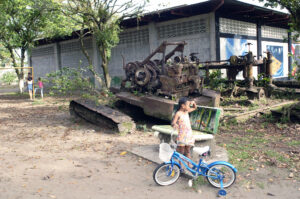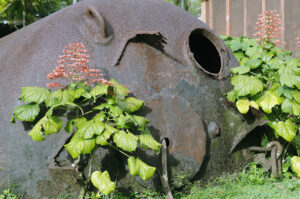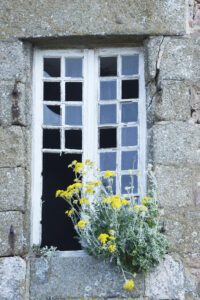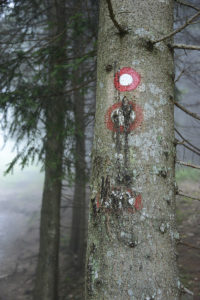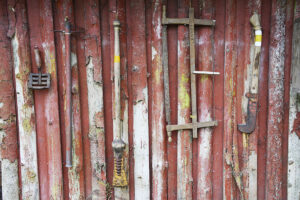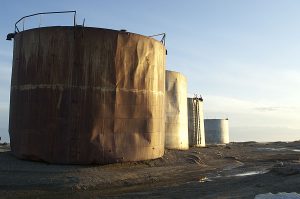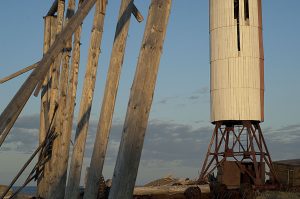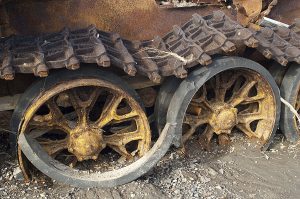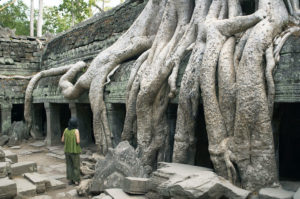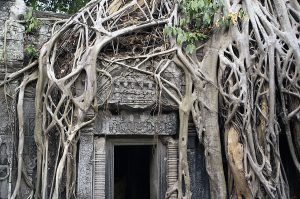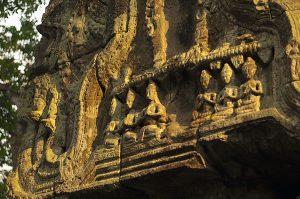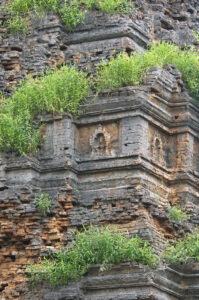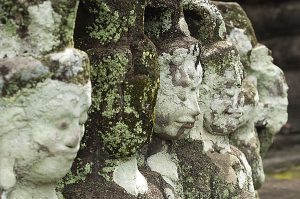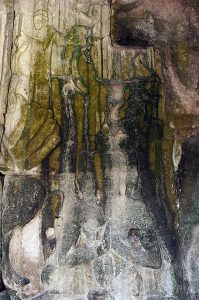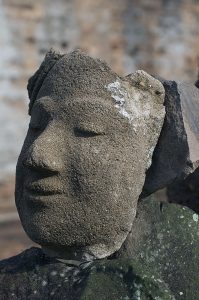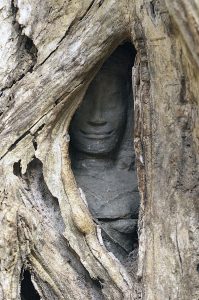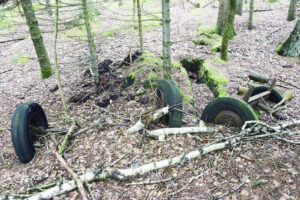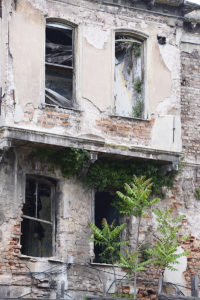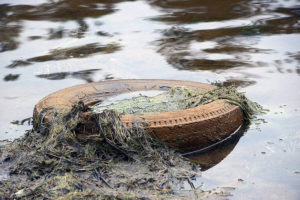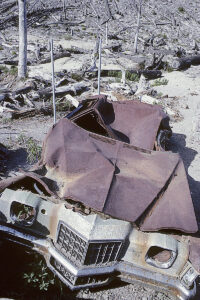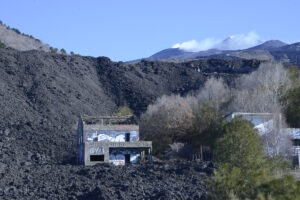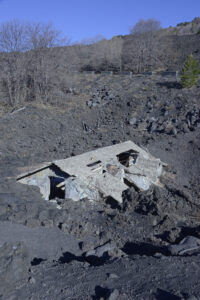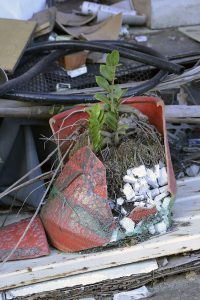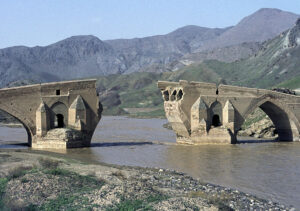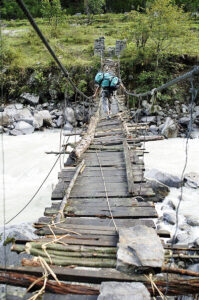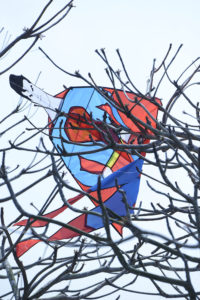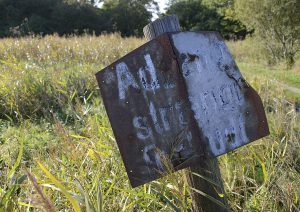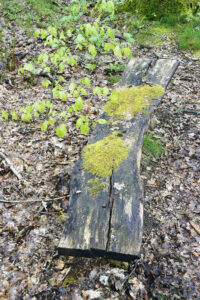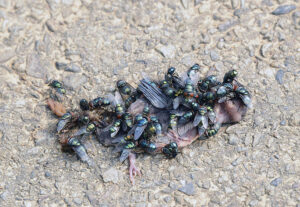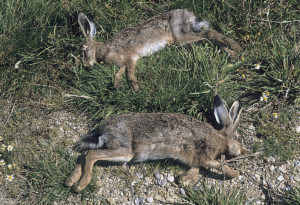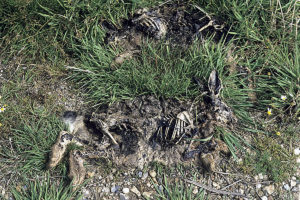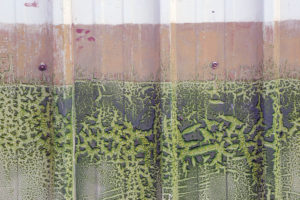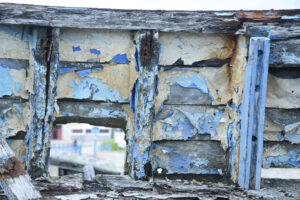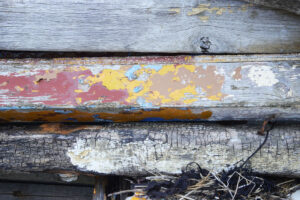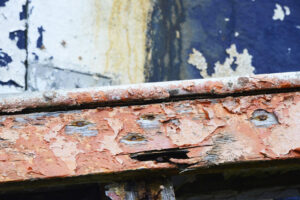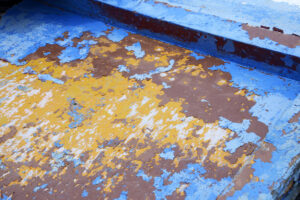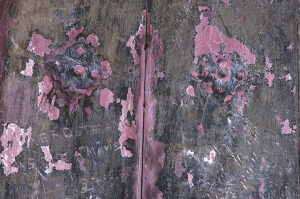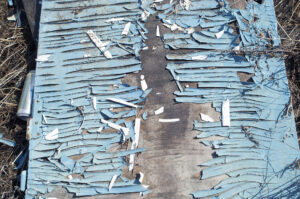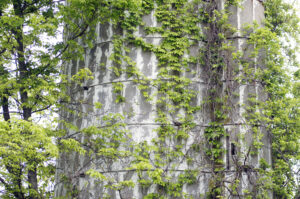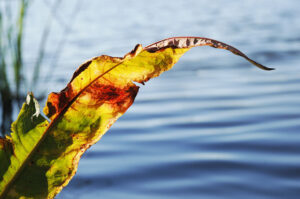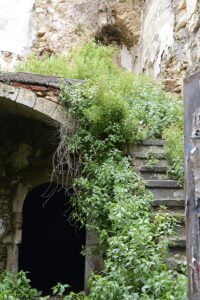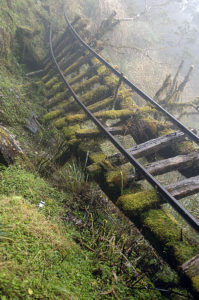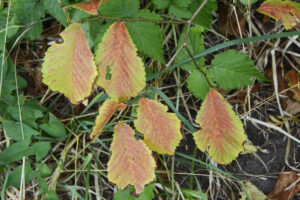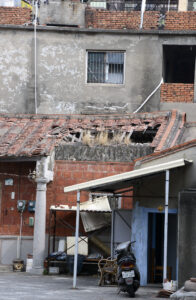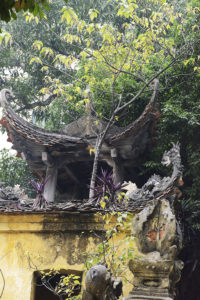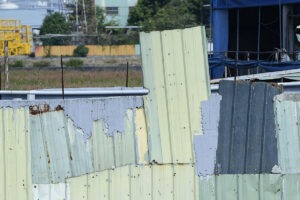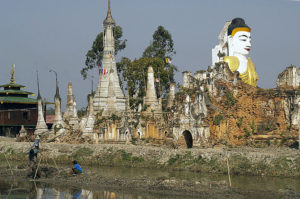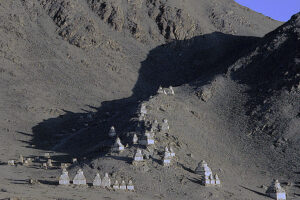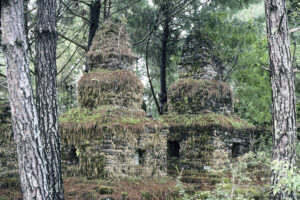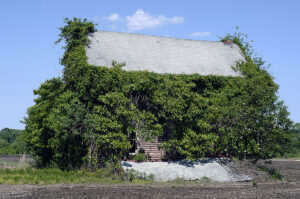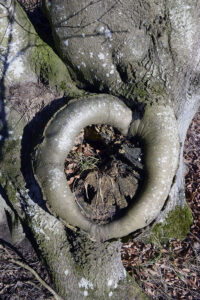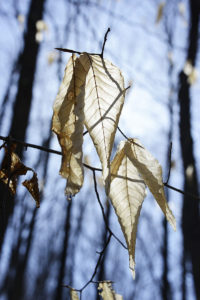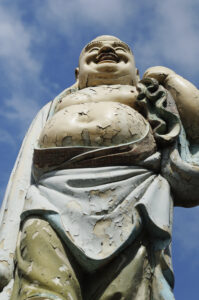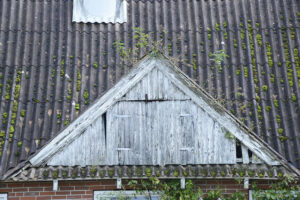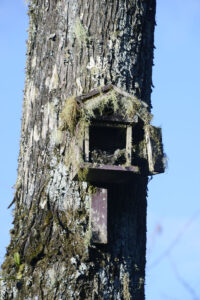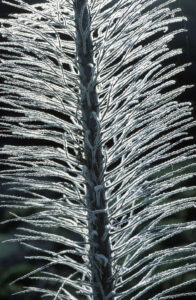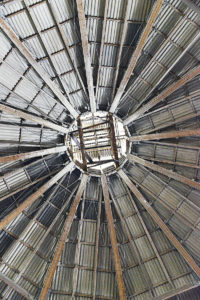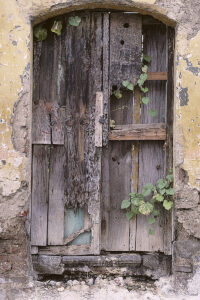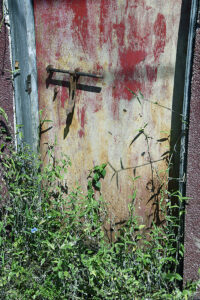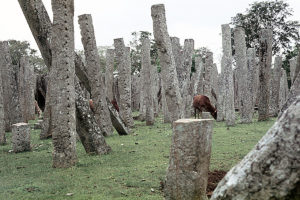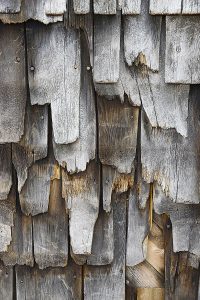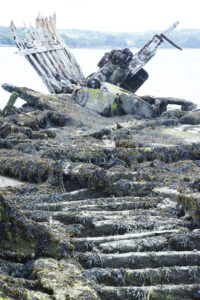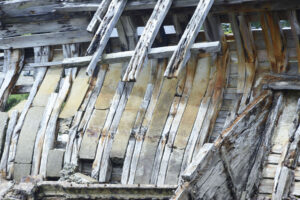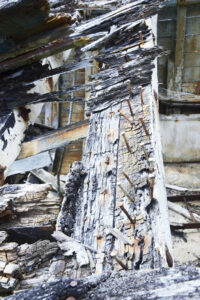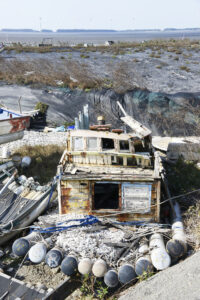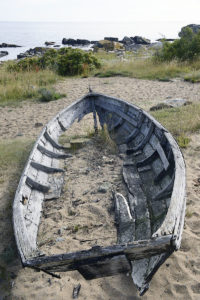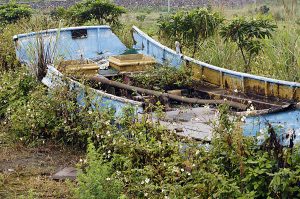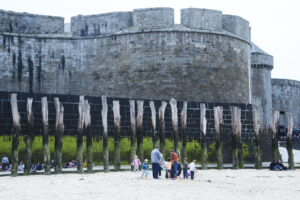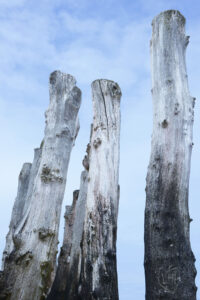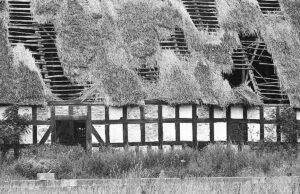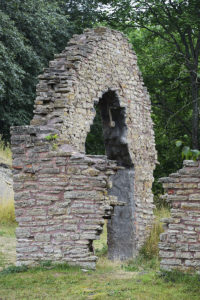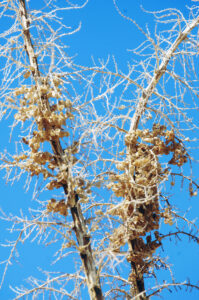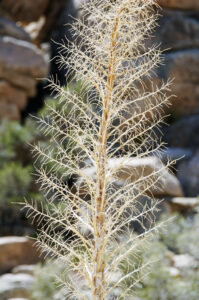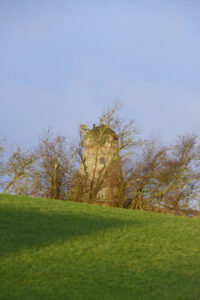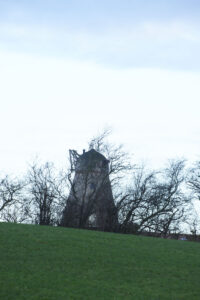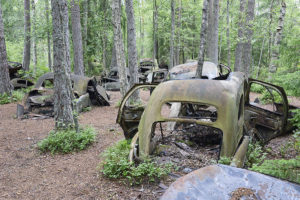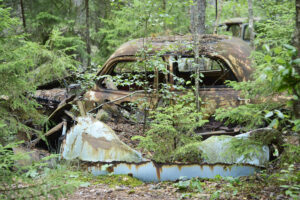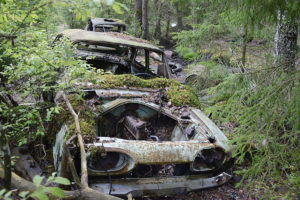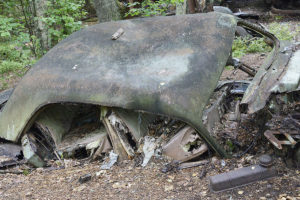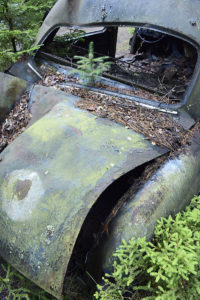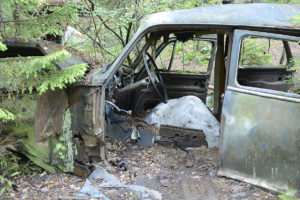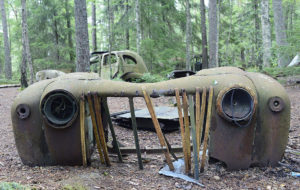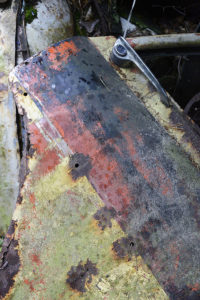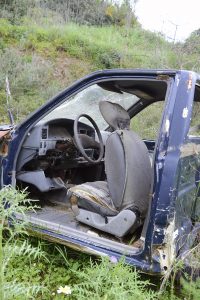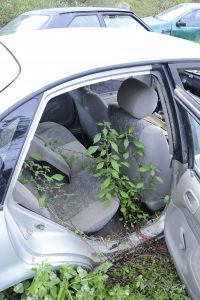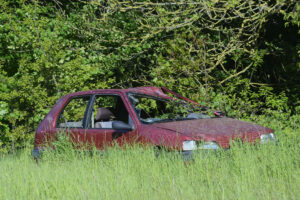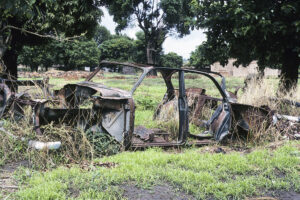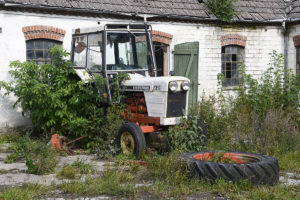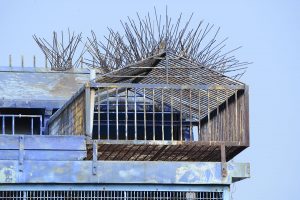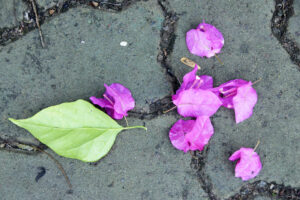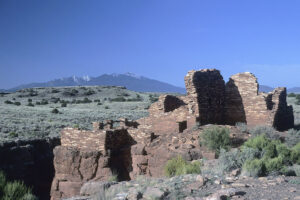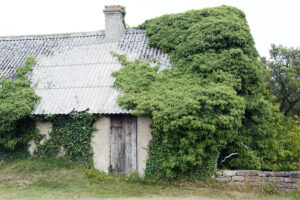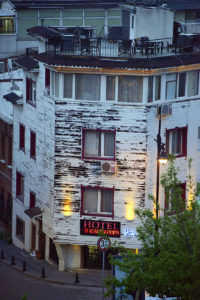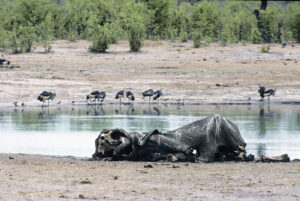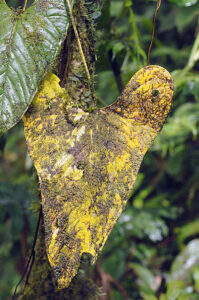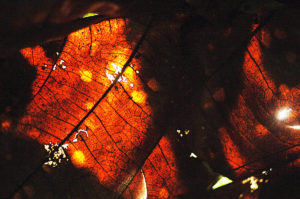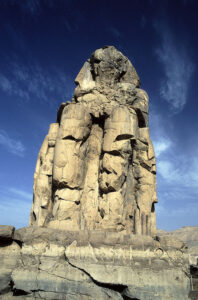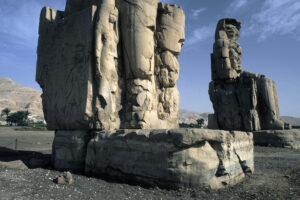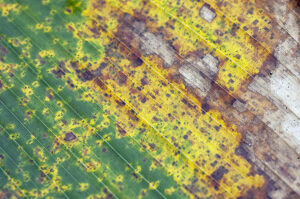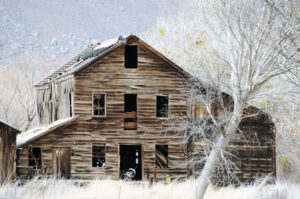Decay
Decay can be very beautiful – evident in the following 4 pictures.
Fallen flowers of the silk-floss tree (Ceiba speciosa) create a magnificent, but short-lived spectacle on the ground, Taichung, Taiwan. (Photo copyright © by Kaj Halberg)
These gorgeous orange-yellow fern leaves were observed in Dasyueshan National Forest, central Taiwan. (Photos copyright © by Kaj Halberg)
Despite having been partly eaten by insects, this withering leaf is still very beautiful. – Lisong Hot Springs, Wulu, eastern Taiwan. (Photo copyright © by Kaj Halberg)
Dead or dying trees are often very photogenic. A selection of pictures, depicting such trees, is shown below.
Dead trees along a road north of Kaitaia, New Zealand. (Photo copyright © by Kaj Halberg)
These pines of the species Pinus nigra ssp. laricio died, when they were partly buried during a volcanic eruption, Etna, Sicily. (Photos copyright © by Kaj Halberg)
Norway spruce (Picea abies), broken during a storm, Store Hjøllund Plantation, Jutland, Denmark. This tree is described on the page Silhouettes. (Photos copyright © by Kaj Halberg)
Dead pines (Pinus) with twisted trunks, Natural Bridges National Monument, Utah, United States. The trunk in the lower picture resembles some long-nosed creature. (Photos copyright © by Kaj Halberg)
Moss-grown, overturned common juniper (Juniperus communis), Salten Langsø, Jutland, Denmark. This species is described on the page Plants: Plants in folklore and poetry. (Photo copyright © by Kaj Halberg)
The doum palm (Hyphaene thebaica) differs from most other palms in that the trunk branches, with leaves at the end of each branch. It is distributed across the African Sahel zone, and in East Africa, from northern Tanzania northwards to Egypt, and also in Israel, Jordan, and the Arabian Peninsula.
Sacred ibises (Threskiornis aethiopicus) (top), and a pink-backed pelican (Pelecanus rufescens), perched atop dead doum palms, Fuloha Oasis, Ethiopia. Both species are described on the page Animals – Birds: Birds in Africa. (Photos copyright © by Kaj Halberg)
In 1895, in the Cardamom Hills, which constitute a part of the West Ghats of South India, the British constructed a dam to supply irrigation water for rice paddies in Tamil Nadu. At its largest, the artificial lake, which is called Lake Periyar, covers an area of c. 50 km2. Around the lake, an area of 777 km2 was later protected, named Periyar National Park.
Even today, more than a hundred years after the construction of the dam, dead trees remain as scrawny poles in the lake.
In the morning fog, these dead trees in Lake Periyar, and their reflection, create what almost resembles a painting by Salvador Dali. (Photo copyright © by Kaj Halberg)
A rare sight in the weel-tended city parks in Taiwan: These fallen and decaying trees have been allowed to remain, Tunghai University Park, Taichung. (Photo copyright © by Kaj Halberg)
Patterns on a decayed tree trunk, from which the bark has fallen off, Horsens Fjord, Denmark. (Photo copyright © by Kaj Halberg)
Once, this Scots pine (Pinus sylvestris) was growing in a dune in De Hoge Veluwe National Park, Gelderland, Holland. Since it was cut down, wind erosion has removed most of the sand around the roots. Scots pine is described on the page Plants: Ancient and huge trees. (Photo copyright © by Kaj Halberg)
Pattern in a root of Scots pine, rasped by a machine, Jutland, Denmark. (Photo copyright © by Kaj Halberg)
Two species of false cypresses are native to Taiwan, the red cypress (Chamaecyparis formosensis) and the yellow cypress (C. taiwanensis), both growing in areas of high precipitation at medium elevations, between 1,300 and 2,600 m altitude. These magnificent trees are described on the page Plants: Ancient and huge trees.
Two red cypresses in Yushan National Park, named the Fuci Trees, were killed by a forest fire in 1963. The dried-out trunks remained standing for many years, but one of them fell in 2019. (Photo copyright © by Kaj Halberg)
Stumps of old red cypresses, Alishan National Forest. An ancient Daoist temple is seen in the lower picture. (Photos copyright © by Kaj Halberg)
Originally, the wild cherry (Prunus avium) was not growing in northern Europe, but finds in kitchen middens from the Viking Age (and not in older middens) indicate that it was introduced at this time. Today, this species is very commonly naturalized in Denmark and southern Sweden.
Cherry species are described in depth on the page Plants: Plants in folklore and poetry.
The bark is peeling off this dead wild cherry, Bornholm, Denmark. (Photo copyright © by Kaj Halberg)
An area covering 323 km2, located along the Ramganga River in the Nainital and Pauri Garhwal districts of Uttarakhand, northern India, was protected in 1936, named Hailey National Park in honour of Sir Malcolm Hailey (1872-1969), who at that time was the Governor of the United Provinces (today the states of Uttar Pradesh and Uttarakhand).
This reserve was renamed in 1954 as Ramganga National Park, which one year later was again renamed as Corbett National Park, in honour of the well-known author, hunter, and naturalist Jim Corbett (1875-1955). – Incidentally, some of Corbett’s often hair-raising adventures are related several other places on this website, including the pages Quotes on Nature, and Animals – Mammals: The spotted killer.
Despite being designated as a national park, part of the area was nevertheless inundated, when the Ramganga Dam, also known as the Kalagarh Dam, was constructed on the borders of the park. This dam, which constitutes part of a huge irrigation and hydroelectric project, was completed in 1974.
In this photograph from 1978, black rain clouds build up behind dead trees in the Ramganga Reservoir, which remain as whitened ‘skeletons’ after being inundated four years prior. (Photo copyright © by Kaj Halberg)
The Himalayan hemlock (Tsuga dumosa) is a magnificent tree, which may grow to 40 m tall. It is very common in the Himalaya, found at altitudes between 2,000 and 3,600 m. Its cones are very small, to 2.5 cm long, with rounded scales. The timber is used for construction, furniture, and foot-bridges, and the foliage is burned as incense in Hindu and Buddhist shrines.
Following a forest fire, two tall stumps is all that remains of this huge Himalayan hemlock in Langtang National Park, central Nepal. (Photos copyright © by Kaj Halberg)
Chinese hemlock (Tsuga chinensis) is distributed from Tibet eastwards to China and Taiwan, and thence southwards to northern Vietnam, growing at altitudes between 1,000 and 3,500 m.
A large tree, to 45 m tall, with scaly, grey or blackish-brown bark, alternating with pale yellowish-brown, corky bark. The linear and flat needles are olive-green, to 2 cm long, arranged spirally, grooved on the upperside, with two white stomatic bands below. Male cones are single or in groups up to 5, purple, to 8 mm long. The small, pendulous female cones are reddish-brown, ovoid, to 2 cm long and 1 cm wide.
Taiwan is home to a variety of Chinese hemlock, formosana, which is quite common in mixed broad-leaved forests in montane areas of the island, at altitudes between 1,700 and 3,500 m. Some authorities question the validity of this variety, claiming that it is identical with the type.
Dead Taiwan hemlocks, Hohuan Shan Mountain. (Photo copyright © by Kaj Halberg)
These trees in southern Zealand, Denmark, were once washed down from the bank to the left, and, over time, wind and sea water have bleached the trunks. (Photo copyright © by Kaj Halberg)
The Torrey pine (Pinus torreyana) is one of the rarest trees in the world, with only about a hundred remaining in the Torrey Pines State Natural Reserve on the coast north of San Diego, and on Santa Rosa Island, California. It was named in honour of American botanist, chemist, and physician John Torrey (1796-1873).
An American crow (Corvus brachyrhynchos) is perched on a dead Torrey pine, Torrey Pines State Natural Reserve, California. (Photo copyright © by Kaj Halberg)
These trees were killed by saltwater, following flooding, Marais de Mousterlin, Brittany. (Photo copyright © by Kaj Halberg)
The generic name of most cormorants, Phalacrocorax, is from the Greek phalakros (‘bald’) and korax (‘raven’), thus ‘the bald raven’, where bald refers to the white crown of great cormorant (P. carbo) during the breeding season.
This bird has an extremely wide, but rather patchy, distribution, found all over Europe and most of Asia, in Australia and New Zealand, and in north-eastern North America and Greenland. In the 1800s, it was persecuted all over Europe, partly because it was competing with fishermen, partly because its caustic guano killed the trees, in which it was breeding.
A large number of cormorant species are presented on the page Fishing.
These trees in Ranthambhor National Park, Rajasthan, India, have been killed by breeding great cormorants. A sambar deer stag (Cervus unicolor) is resting beneath the trees, and a marsh crocodile (Crocodylus palustris) is basking on the lake shore to the right. (Photo copyright © by Kaj Halberg)
This tree near Les Grangettes, Geneva Lake, Switzerland, which serves as a night roost for wintering great cormorants, has now turned white, completely covered in guano. A highway is seen in the background. (Photo copyright © by Kaj Halberg)
Coral Pink Sand Dunes State Park in south-western Utah, United States, is named for its sand dunes, the major part of which have a reddish hue. These dunes were formed from material, which was eroded off the pinkish-coloured Navajo sandstone rocks surrounding the park. The dunes are estimated to be between 10,000 and 15,000 years old. (Source: stateparks.utah.gov/parks/coral-pink/about)
This tree in Coral Pink Dunes State Park was engulfed by moving sand, and now only a stump remains. (Photo copyright © by Kaj Halberg)
Downy birch (Betula pubescens) and silver birch (B. pendula) are both widespread and common in Europe, in the Caucasus, and eastwards across Siberia to the Pacific, and silver birch is also found in China and Japan. The name birch is derived from Proto-Germanic berko, in all probability rooted in Sanskrit bhurja, the name of a species of birch.
Both species are described on the page Plants: Ancient and huge trees.
Decayed birch with birch polypores (Piptoporus betulinus), central Jutland, Denmark. This fungus often attacks live birch trees, over time killing them. (Photo copyright © by Kaj Halberg)
Darters (Anhinga), also called snakebirds due to their long, thin, flexible neck, are large water birds, comprising two or four species. The American darter (Anhinga anhinga), often called just anhinga, lives in the New World, whereas one or three species are found in the Old World. If the three Old World darters are lumped, they are called A. melanogaster. Some authorities, however, recognize three full species: Oriental (A. melanogaster), African (A. rufa), and Australasian (A. novaehollandiae).
Oriental darter, resting in a dead tree, Keoladeo National Park, Rajasthan, India. (Photo copyright © by Kaj Halberg)
Some time ago, these spruce trees (Picea) in central Jutland, Denmark, were felled, and they were also stacked, but have since been ’forgotten’. (Photos copyright © by Kaj Halberg)
Lichens and mosses, growing on a decayed spruce trunk, Jutland, Denmark. (Photo copyright © by Kaj Halberg)
The Mesquite Flat Sand Dunes are situated in the northern part of Death Valley National Park, California. This area used to be covered in growths of mesquite (Prosopis), of the pea family (Fabaceae), hence the name of the area, Mesquite Flat. However, as the dunes advanced, most of these trees disappeared, some remaining as coppices of dead trees among the dunes, which reach a height of up to 30 m.
Coppice of dead mesquite trees, Mesquite Flat Sand Dunes. (Photo copyright © by Kaj Halberg)
In the wild, the giant sequoia (Sequoiadendron giganteum) is found only in the Sierra Nevada, eastern California. Specimens of these magnificent trees are the heaviest living beings on the planet, the largest ones having an estimated weight of c. 2,100 tonnes.
In his book My First Summer in the Sierra, from 1911, Scottish-American writer and environmentalist John Muir (1838-1914) writes the following about giant sequoia: “I found a black, charred stump about thirty feet in diameter and eighty or ninety feet high – a venerable, impressive old monument of a tree that in its prime may have been the monarch of the grove.”
Other pictures, depicting these remarkable trees, may be seen on the pages Plants: Ancient and huge trees, and Plants: Plants of Sierra Nevada.
Charred remains of a giant sequoia, which succumbed to a forest fire, Sequoia National Park, Sierra Nevada. (Photo copyright © by Kaj Halberg)
As a breeding bird, the whiskered tern (Chlidonias hybrida) has a very wide, but spotty distribution, found in southern and eastern Europe, west-central Asia, East Asia, northern India, Indonesia, Australia, and the southern part of Africa. In winter, it occurs in most of Africa, Tropical Asia, and Australia.
The generic name is from the Greek khelidonios (‘swallow-like’), from khelidon (‘swallow’), referring to the elegant flying style of Chlidonias terns. The specific name, meaning ‘hybrid’ in Latin, was applied by Prussian naturalist Peter Simon Pallas (1741-1811), who presumed that the bird he shot was a hybrid between white-winged tern (Chlidonias leucoptera) and common tern (Sterna hirundo). (Source: Jobling, J.A. 2010. The Helm Dictionary of Scientific Bird Names. Christopher Helm, London)
Numerous whiskered terns, resting in a dead tree together with four little cormorants (Microcarbo niger), Giritale Wewa, Polonnaruwa, Sri Lanka. (Photo copyright © by Kaj Halberg)
The goat willow (Salix caprea) is a smallish tree, native to almost all of Europe, the Caucasus, and parts of Central Asia. The pictures below show the decay of an old goat willow, growing in Nature Reserve Vorsø, Horsens Fjord, Denmark. Many aspects of this interesting nature reserve are described on the page Nature Reserve Vorsø.
In this picture from 1982, the goat willow on Vorsø is about 50 years old. Its trunks have broken apart and are now lying on the ground, spread out star-like. However, the tree is still full of vigour. (Photo copyright © by Kaj Halberg)
In 2004, 22 years later, the tree has finally succumbed, the trunks covered in mosses. (Photo copyright © by Kaj Halberg)
In 2018, 36 years after the upper picture was taken, only a few remains of the willow can be seen. (Photo copyright © by Kaj Halberg)
One day, towards the end of April 1992, I was hiking up a slope in Inyo National Forest, White Mountains, eastern California. In front of me were the most remarkable trees I have ever seen. At a distance, they appeared completely dead, with twisted, naked branches, stretching from a yellowish trunk towards the blue sky.
But then – at closer quarters I noticed a narrow strip of bark on the side of the trunk, which pointed away from the direction of the prevailing wind. This strip of bark was leading up to one or two branches, densely covered in green needles, and from the tip of these branches, small cones were hanging down, their scales equipped with bristle-like appendages.
These peculiar trees were Great Basin bristlecone pines (Pinus longaeva), which is restricted to high-altitude areas in eastern California, Nevada, and Utah. Apart from certain clones, including a creosote (Larrea tridentata) in the Mohave Desert, whose age is estimated at c. 9,400 years, this pine is the oldest living organism on Earth, a few of them being around 5,000 years old.
Other pictures, depicting these remarkable trees, are shown on the pages Plants: Ancient and huge trees, and Plants: Plants of Sierra Nevada.
Ancient Great Basin bristlecone pines, Inyo National Forest, White Mountains, California. (Photos copyright © by Kaj Halberg)
Common, or European, ash (Fraxinus excelsior), of the olive family (Oleaceae), is a native of Europe, eastwards to the Caucasus and the Alborz Mountains in northern Iran. It has also become naturalized a few places in New Zealand, the United States, and Canada.
In later years, populations of this ash species have been much reduced by ash dieback, a disease caused by a fungus, Hymenoscyphus fraxineus, previously called Chalara fraxinea. Most trees that contract this disease die after a few years. However, research has shown that some trees may have resistance to it.
Dead ash trees at the edge of a swamp, Langeland, Denmark. Behind the trees are common hawthorn bushes (Crataegus monogyna), full of fruits. (Photo copyright © by Kaj Halberg)
Dead trees and the Moon, Bryce Canyon National Park, Utah, United States (top), and Karnataka, South India. (Photos copyright © by Kaj Halberg)
Dead tree with a dead climber, observed in a city park, Taichung, Taiwan. The reddish colour in the background is caused by leaves of Chinese tallow-tree (Triadica sebifera). A number of pictures, depicting the gorgeous winter foliage of this tree, are shown on the page Autumn. (Photo copyright © by Kaj Halberg)
The Himalayan silver fir (Abies spectabilis) can grow to very large proportions, to 50 m tall, with a trunk up to 1.5 m across. This species is very common in the Himalaya, found from Afghanistan eastwards to Myanmar. It is widely used locally, its wood for construction, carpentry, furniture, paper-making, and firewood. The foliage is utilized medicinally for asthma, bronchitis, colds, and rheumatism, and is also burned as incense.
Patterns on the trunk of a burned Himalayan silver fir, encountered on the Lamjura La Pass (3530 m), Solu, eastern Nepal. The yellow fungus in the lower left part of the picture is a species of stagshorn (Calocera). (Photo copyright © by Kaj Halberg)
Taiwan fir (Abies kawakamii) is a medium-sized tree, which may reach a height of 35 m in sheltered places, with a trunk diameter up to 1 m. At high altitudes it is usually low and stunted. The bark is peeling on older individuals. The needles are up to 2.8 cm long, and the cones are rather small, to 7.5 cm long, cylindric, dark blue.
This species is restricted to the highest mountain tops of Taiwan, at elevations between 2,400 and 3,800 m. It is declining, as many populations have become fragmented, fire being the main threat.
The specific name honours Japanese botanist Takiya Kawakami (1871-1915), who worked as a botanist for the Japanese government in Taiwan from 1901. He collected numerous plants there, and several species are named after him.
These Taiwan firs, observed at an altitude of c. 3,000 m on Hohuan Shan Mountain, have succumbed, presumably due to disease or frost. (Photo copyright © by Kaj Halberg)
The mu oil tree (Vernicia montana, formerly called Aleurites montana or A. cordata) is a smallish tree of the spurge family (Euphorbiaceae), native to southern China, Taiwan, Vietnam, Thailand, and Myanmar. In spring, it displays an abundance of wonderful flowers, many pictures of which are shown on the page Plants: When the mu oil tree is flowering.
The bark is peeling off this dead mu oil tree in Tunghai University Park, Taichung, Taiwan. (Photo copyright © by Kaj Halberg)
The blackboard tree (Alstonia scholaris), also called a number of other names, including devil tree, milkwood-pine, and white cheesewood, belongs to the dogbane family (Apocynaceae). It grows in mixed forests from the Indian Subcontinent eastwards to south-western China, and thence south through Southeast Asia and the Philippines to the Indonesian Archipelago and New Guinea to northern Australia. Bark and leaves are utilized medicinally for headache, influenza, bronchitis, and pneumonia, and the wood is used for making coffins.
The trunk of this blackboard tree is partly decayed, but the tree is still alive. This species is very commonly planted in Taiwan, where this picture was taken. (Photo copyright © by Kaj Halberg)
The kauri tree (Agathis australis) is a conifer of the family Araucariaceae, which is restricted to the northernmost part of New Zealand’s North Island. This species is among the world’s largest trees, growing to over 50 m tall, with trunk girths up to 16 m. Although their age is difficult to estimate, it is believed that they may live for more than 2,000 years. They are out of an ancient group of trees, which first appeared during the Jurassic period (190 to 135 million years ago).
The sad fate of the kauri tree is described on the page Plants: Ancient and huge trees.
The rotting base of an ancient kauri tree, Waipoua Forest. (Photo copyright © by Kaj Halberg)
On the trunk of this dead tree, growing on the slopes of the volcano Gunung Rinjani, Lombok, Indonesia, a unique zigzag pattern is seen beside a knot. (Photo copyright © by Kaj Halberg)
As its specific and common names imply, needles of single-leaf piñon (Pinus monophylla) do not sit in groups, but singly – the only pine in the world with this arrangement. This species, one among several pines of the piñon pine group, is native to western United States and north-western Mexico, from eastern and southern California and Baja California Peninsula eastwards to southernmost Idaho, Utah, and south-western New Mexico.
This tree, which can grow to 20 m tall, usually occurs at altitudes between 1,200 and 2,300 m. It is very common, often forming open woodlands, and often mixed with junipers (Juniperus). Previously, the edible nuts were an important source of food for indigenous peoples, and they are still widely harvested.
Dead single-leaf piñon, Joshua Tree National Park, California. (Photos copyright © by Kaj Halberg)
The Karioi Lakes are two small lakes near the town of Ohakune, North Island, New Zealand. The upper lake, Rotokura, is situated in an ancient volcanic crater and is sacred to the Maori people. The water in this lake is a gorgeous shade of green, almost turquoise. The lower lake is often called Dry Lake, although it contains lots of water. Presumably, it got this name from its swamp-like appearance. This lake is artificial, and when the area was dammed, many trees were submerged and died.
These trees in Dry Lake died, when the area was dammed, and now remain as hardened ‘skeletons’. (Photo copyright © by Kaj Halberg)
Dilapidated graves are often decorative and photogenic. Below, a number of examples are shown. A large selection of pictures, depicting graves, may be seen on the page Culture: Graves.
This old cemetery from the Dutch colonial period, in the city of Kochi, Kerala, South India, has become completely overgrown by corallita (Antigonon leptopus), a vine of the pinkweed family (Polygonaceae). (Photo copyright © by Kaj Halberg)
Graves in a cemetery near Pueblo Pampa Union, a deserted mining town north of Carmen Alto, Chile. The grave in the bottom picture has been opened, possibly by grave robbers. Bits of leaves have been placed in the eye sockets of the deceased. (Photo copyright © by Kaj Halberg)
In Taiwan, on the so-called Tomb Sweeping Day, grasses and other wild plants, which have invaded Daoist graves, are burned by relatives, who then clean the grave and worship their ancestors.
When a tomb is no longer used, relatives often smash the grave and split the tombstone. The pictures below show two abandoned graves near the city of Taichung. Fire from burning grass on nearby graves has spread to the grave in the lower picture.
Other aspects of Daoism are described on the page Religion: Daoism in Taiwan.
(Photos copyright © by Kaj Halberg)
These pictures show another abandoned Daoist grave in Taichung. Next to the broken jar, a golden-rain tree (Koelreuteria elegans), of the soapberry family (Sapindaceae), has sprouted. This tree is described on the page In praise of the colour yellow. (Photos copyright © by Kaj Halberg)
The same grave, 5 years later. The jars have disappeared, and the golden-rain tree has grown quite big. (Photo copyright © by Kaj Halberg)
In Taiwan, lion sculptures are often placed as guardians on Daoist graves and outside temples. A number of pictures, depicting such sculptures, are shown on the page Culture: Graves, whereas the role of the lion in daoism is described on the page Religion: Daoism in Taiwan.
This lion sculpture, encountered in a cemetery near Taichung, has fallen into decay, but has nevertheless been adorned with ribbons. (Photo copyright © by Kaj Halberg)
Skulls and bones of white-bearded wildebeests (Connochaetes taurinus ssp. mearnsi), scattered on the shore of Masek, a soda lake in Serengeti National Park, Tanzania. In the background Mt. Lemagrut (3132 m). Wildebeests are described on the page Animals – Mammals: Antelopes. (Photo copyright © by Kaj Halberg)
This dilapidated chair, observed at Wufong, western Taiwan, has been overgrown by a climber. (Photo copyright © by Kaj Halberg)
Another chair, which is not what it used to be! – Taichung, Taiwan. (Photo copyright © by Kaj Halberg)
As its name implies, the most important food item of the acorn woodpecker (Melanerpes formicivorus) is acorns. It has an interesting habit of storing acorns as a winter supply in small holes, which the bird chisels into the bark of living or dead trees. This bird is common from California through Mexico and Central America to northern Columbia.
Acorn woodpecker, sitting on a dilapidated windmill in Ronald W. Caspers Wilderness Park, Santa Ana Mountains, California, which was formerly used to pump up drinking water for cattle. (Photo copyright © by Kaj Halberg)
This dead trunk of a blue oak (Quercus douglasii), growing in Cache Creek Wilderness Area, California, is functioning as a storage place of acorns, made by an acorn woodpecker. (Photo copyright © by Kaj Halberg)
This oil drum was placed in front of this house in Taichung, Taiwan, and filled up with a mixture of stones and cement, to prevent people from parking their cars here. Despite its advanced stage of decay, the drum is still fulfilling its purpose. (Photo copyright © by Kaj Halberg)
Withered stems of false oat-grass (Arrhenatherum elatius), Funen, Denmark. This grass is very common, distributed across Europe, western Asia, and northern Africa. It is described on the page Plants: Grasses. (Photo copyright © by Kaj Halberg)
Dried-out fish, Doubtless Bay, Karikari Peninsula, New Zealand. (Photo copyright © by Kaj Halberg)
Withering fern leaves are often very attractive. A selection is shown below.
Bracken (Pteridium aquilinum) has an almost cosmopolitan distribution, found in most temperate and subtropical regions of the world. Areas, which have been utilized for farming or grazing, and then abandoned, are readily invaded by bracken, which can cover huge areas, hindering growth of other species.
Various autumn colours in a large growth of bracken, Jutland, Denmark. (Photo copyright © by Kaj Halberg)
These withering fern leaves were both photographed in New Zealand. (Photos copyright © by Kaj Halberg)
Drynaria propinqua, an epiphytic basket fern of the polypody family (Polypodiaceae), has a wide distribution, from the Himalaya eastwards to China, and thence southwards to Southeast Asia.
Withered sterile fronds of Drynaria propinqua, partly eaten by micro-organisms, Ghumna, Langtang National Park, central Nepal. (Photo copyright © by Kaj Halberg)
The common polypody (Polypodium vulgare) is distributed in Europe and North Africa, growing mainly in cooler, shaded locations, such as forests, where it is often found at the base of trees, on rocks, and on old stone fences.
The generic and common names are derived from the Greek poly (‘many’) and pous (‘foot’), in allusion to its many equal lobes on the leaf. In former times, polypody was utilized in cooking, and in traditional medicine as a purgative and vermifuge. This species has been introduced to New Zealand, where it is often regarded as an invasive.
Autumn leaves of common polypody with sporangies, Bornholm, Denmark. (Photo copyright © by Kaj Halberg)
Most members of the hard-fern genus, Blechnum, have rather short and rather stiff leaflets, but, as its name implies, the leaves of the palm-leaf fern (Blechnum novae-zelandiae) are larger, up to 2 m long and 50 cm wide, somewhat resembling palm leaves. This species, which is very common in New Zealand, may also be identified by its sporangies, forming at the tip of the leaves, which turn black when ripe.
Withering leaves of palm-leaf fern, Rotokura Lake, New Zealand. (Photos copyright © by Kaj Halberg)
The common male fern (Dryopteris filix-mas) is widely distributed in temperate areas in the Northern Hemisphere. As far back as the time of Greek scholar and botanist Theophrastos (c. 371 – c. 287 B.C.), and physician, pharmacologist, and botanist Pedanius Dioscorides (died 90 A.D.), who was the author of De Materia Medica (five volumes dealing with herbal medicine), it was known that the rhizome of this species would expel intestinal worms.
This species is described in depth on the page Plants: Plants in folklore and poetry.
This common male fern has almost been covered by snow, Horsens Fjord, Denmark. (Photo copyright © by Kaj Halberg)
Cleared areas in the Himalaya, which lie fallow, are often invaded by large growths of a huge species of fern, Diplopterygium giganteum (formerly named Gleichenia gigantea), which belongs to the family Gleicheniaceae, popularly called forked-ferns. This species is distributed from Nepal eastwards to China and Southeast Asia.
Withering leaf of Diplopterygium giganteum, Gul Bhanjyang, Helambu, Nepal. (Photo copyright © by Kaj Halberg)
The leaflets of this withering fern are curling up in a spectacular way. – Dasyueshan National Forest, central Taiwan. (Photo copyright © by Kaj Halberg)
As their name implies, tree ferns grow a wooden trunk. The rough tree fern (Dicksonia squarrosa), which is endemic to New Zealand, has a black and slender trunk, growing to a height of up to 6 m, and usually surrounded by a ‘gown’, consisting of numerous withered fronds.
Rough tree fern, Jubilee Park, Ohakune, New Zealand. (Photo copyright © by Kaj Halberg)
Shiva is one of the supreme gods in the Hindu pantheon. Over the years, this sculpture in Ubud, Bali, Indonesia, depicting Shiva and his mount, the bull Nandi, has been covered in lichens and green algae. (Photo copyright © by Kaj Halberg)
Only the top of this bunker from World War II is protruding from a sandy beach, Thy, Denmark. (Photo copyright © by Kaj Halberg)
Undoubtedly, the best known of all cactus species is the huge saguaro (Carnegiea gigantea), which can grow to a height of 12 m. It has been used as a decorative background in countless western films, but is in fact of a rather limited distribution, growing only in the Sonoran Desert of Mexico and southern Arizona, and in a small area in adjacent California.
Other pictures, depicting this species, and many other cacti, may be studied on the page Plants: Cacti.
Withered ‘skeleton’ of a saguaro, Lake Saguaro, east of Phoenix, Arizona. (Photos copyright © by Kaj Halberg)
About 1600 B.C., an Indo-European people, whom we call Hittites, established an empire, centered around the city of Hattuşa, whose ruins are situated near the present town of Boğazkale, central Anatolia, Turkey. This empire reached its peak around 1350-1300 B.C., during the rule of King Suppiluliuma I, when the major part of Anatolia, as well as what is today northern Lebanon, Syria, and Iraq, were conquered.
The term Hittite is modern, taken from the Bible, and has nothing to do with this people. They called themselves the ‘People of the Land of Hatti’.
In 2006, when this picture was taken, not much was left of the once imposing Lion Gate in Hattuşa, thus named due to the lion sculptures in front of the entrance. The face of the lion to the left was restored in 2011. To the Hittites, the lion was a symbol of power and protection. (Photo copyright © by Kaj Halberg)
Weather-worn relief on a rock wall in the Hittite city of Yasilikaya, which was situated near the capital Hattuşa. The image shows a procession, probably of nobility. (Photo copyright © by Kaj Halberg)
Dilapidated barns are often very fascinating and extremely photogenic. A selection is shown below.
Washington, New Jersey, United States. (Photo copyright © by Kaj Halberg)
Stevns, Zealand, Denmark. (Photo copyright © by Kaj Halberg)
Raetihi, New Zealand. (Photo copyright © by Kaj Halberg)
Salt Point State Park, California. (Photo copyright © by Kaj Halberg)
Lyø, Funen, Denmark. (Photo copyright © by Kaj Halberg)
Norra Bäck, Öland, Sweden. (Photo copyright © by Kaj Halberg)
Dilapidated electricity meter box in the village of Krissos, western Crete. The plant beneath the box is a species of Veronica. (Photo copyright © by Kaj Halberg)
Lobster trap, covered by barnacles, Mount Island, Acadia National Park, Maine, United States. (Photo copyright © by Kaj Halberg)
Teak (Tectona grandis) is a large, deciduous, tropical tree, belonging to the mint family (Lamiaceae). It grows to about 40 m tall and is charactereized by having very large leaves, to 45 cm long and 23 cm wide. It is native to the Indian Subcontinent, Indochina, Malaysia, and Indonesia, but is cultivated in many other countries and has become naturalized in several places.
Decaying teak leaf, Hanoi Botanical Garden, Vietnam. (Photo copyright © by Kaj Halberg)
This old-fashioned whetstone is pivotally mounted on an iron bar, which is secured in two granite stones, Avernakø, Funen, Denmark. (Photo copyright © by Kaj Halberg)
Rusted iron is often very decorative. Some examples are shown below.
Rusted tin sheets, covering a wall in Valparaiso, Chile. (Photo copyright © by Kaj Halberg)
Rusted hay tedder, central Jutland, Denmark. (Photo copyright © by Kaj Halberg)
Rusted tank, near Pont des Espagnols, Brittany. (Photos copyright © by Kaj Halberg)
The information on this sign has vanished due to rust, Taichung, Taiwan. (Photo copyright © by Kaj Halberg)
Rusted roof of corrugated iron, glowing in the evening light, Jutland, Denmark. (Photo copyright © by Kaj Halberg)
This metal wall in Taichung, Taiwan, was painted in a hurry, and some of the paint ran down the wall. As it was painted white, the sloppy work was not visible, until part of the wall rusted. (Photo copyright © by Kaj Halberg)
Rusted wheel of a scrapped harvester, Jutland, Denmark. (Photo copyright © by Kaj Halberg)
Rusted machinery, Taichung, Taiwan. (Photo copyright © by Kaj Halberg)
Rusted anchors, left on a beach, Byrums Sandfelt, Öland, Sweden. (Photo copyright © by Kaj Halberg)
This drum was washed ashore in Nature Reserve Vorsø, Horsens Fjord, Denmark, and is now rusted through in several places. (Photo copyright © by Kaj Halberg)
Rusted equipment on board a decaying wooden boat, Le Fret, Crozon, Brittany. (Photos copyright © by Kaj Halberg)
Bell-shaped porcelain insulator with deposits of rust, left by the wire, which has eroded away, Funen, Denmark. (Photo copyright © by Kaj Halberg)
Rusted wire is still attached to this one, Thy, Denmark. (Photo copyright © by Kaj Halberg)
Another insulator with rusted wire, and lichens on the fence post, central Jutland, Denmark. (Photo copyright © by Kaj Halberg)
Rusted fan with a dead climber, Taichung, Taiwan. (Photo copyright © by Kaj Halberg)
Rusted winch in an abandoned fishing village, formerly utilized for hauling boats ashore, Alvedsjö Bodar, Öland, Sweden. (Photo copyright © by Kaj Halberg)
Rust creates patterns on a wall, Taichung, Taiwan. (Photo copyright © by Kaj Halberg)
Rusted sign on a pole in Mukkali, Kerala, South India, warning against high voltage, with text in English and in the local language, Malayalam. (Photo copyright © by Kaj Halberg)
Rusted water tower, Taichung, Taiwan. (Photo copyright © by Kaj Halberg)
Rusted machinery, Tortuguero, Limón, Costa Rica. The plant is Javan glorybower (Clerodendrum paniculatum). (Photos copyright © by Kaj Halberg)
Decayed window in a former lighthouse residence, Cap Frehel, Brittany. Silver ragwort (Senecio cineraria, also known as Jacobaea maritima) has sprouted in a crack in the window sill. This plant is distributed from France and Italy eastwards to Turkey, southwards to north-western Africa. (Photo copyright © by Kaj Halberg)
Over the years, this spruce tree near the village of Prtovc, Triglavski National Park, Slovenia, has grown larger, and as the markings, which denote a hiking trail, have become blurred, new ones have been added. (Photo copyright © by Kaj Halberg)
These old tools have been placed as decoration on the wall of a dilapidated shed, central Jutland, Denmark. (Photo copyright © by Kaj Halberg)
During the heydays of the Soviet Union, the town of Anadyr, situated on the Chukotka Peninsula, eastern Siberia, was of huge importance due to the presence of a gigantic missile launch, in which several missiles, armed with nuclear weapons, were aimed at various targets in the United States. Following the collapse of the Soviet Union, the whole business was covered with soil, and the importance of Anadyr vanished.
Today, this area bears the marks of decay and indifference, in equal measures. Rubble, wires, iron pipes, oil drums, scrapped trucks, workmen’s huts, and a lot of other rubbish is ubiquitous, and nobody cares to clean up the mess. During the Soviet Era, you just did what you were told, which does not exactly encourage personal initiative. Today, when you are not told to do anything, it seems that nobody wants to take the trouble to clear the mess, and thus beautify the area.
Elsewhere in Chukotka, a lively town existed on the sandspit Kosa Nikolaya, clustered around a harbour, from where supplies were brought to a huge gold diggers’ camp in the nearby Zolotoi Khrebet (’Golden Ridge’) Mountains. Today, the buildings on the sandspit are empty and deserted, some of the huge oil tanks are slanting a bit, while rusted machines, trucks, wires, and a collection of other items, are scattered all over the landscape.
Our adventures in Chukotka are related on the page Travel episodes – Siberia 2011: Caterpillar trip in Chukotka.
A pile of garbage in front of an abandoned factory building in Anadyr – one of these huge concrete buildings, devoid of charm, which the former Soviet government was so fond of building. (Photo copyright © by Kaj Halberg)
Near Anadyr, the cannon on this army tank blew up, and the tank was discarded on the spot. (Photo copyright © by Kaj Halberg)
These huge oil tanks on the Kosa Nikolaya spit are slanting a bit. (Photo copyright © by Kaj Halberg)
Beams and tall container, Kosa Nikolaya. (Photo copyright © by Kaj Halberg)
Rusted truck, Kosa Nikolaya. (Photo copyright © by Kaj Halberg)
Broken belt on a caterpillar, Kosa Nikolaya. (Photo copyright © by Kaj Halberg)
Rusted window frame in a building, Kosa Nikolaya. (Photo copyright © by Kaj Halberg)
The Hindu Khmer Empire (c. 800-1430 A.D.), which ruled in most of Southeast Asia and parts of southern China, left a superb legacy in the form of the Angkor Wat ruins, situated in present-day Cambodia.
In the 19th century, when European explorers visited the ruins, most of them were overgrown by rainforest. Since then, most of the vegetation has been removed, and many of the ruins have been restored. In many places, however, various signs of decay are still seen, as shown in pictures below.
The Khmer culture is described in depth on the page Religion: Hinduism.
Ta Prohm is one of the few complexes in the Angkor area, which has been preserved in the state it was found. These pictures show ruins, overgrown by huge rainforest trees, Tetrameles nudiflora (top), and Ficus gibbosa, a strangler fig. Both species are described on the page Plants: Ancient and huge trees. (Photos copyright © by Kaj Halberg)
This ruin in Ta Prohm with lichen-encrusted sculptures, depicting Khmer nobility, is illuminated by the late afternoon sun. (Photo copyright © by Kaj Halberg)
Ruined pagoda, overgrown by vegetation, Lolei, Roluos (Hariharalaya). (Photo copyright © by Kaj Halberg)
Lichen-encrusted frieze, depicting carved faces, Angkor Thom. Water is trickling down one of the faces, making it darker, and overgrown by mosses and lichens. (Photo copyright © by Kaj Halberg)
This relief in Angkor Thom depicts a seated Hindu god. The image is blurred by seeping water, which causes an exuberant growth of green algae. (Photo copyright © by Kaj Halberg)
All that remains of this sculpture in Phnom Krom, depicting a woman, is her beautiful face. (Photo copyright © by Kaj Halberg)
In Hinduism, apsaras are supernatural female beings, superb in the art of dancing. They are often depicted dancing to music, delivered by Gandharvas, court musicians of the rain god Indra. They entertain and sometimes seduce gods and men.
Over time, this Khmer sculpture at Ta Prohm, Angkor Wat, Cambodia, which may depict an apsara, has been almost completely enveloped by a huge strangler fig (Ficus). (Photo copyright © by Kaj Halberg)
Remains of a wagon, which has sunk into a marshy forest bottom, central Jutland, Denmark. (Photo copyright © by Kaj Halberg)
Abandoned house, Sultanahmet, Istanbul, Turkey. An elm-leaved sumac (Rhus coriaria) has taken root on the wall. This species is described on the page Plants: Urban plant life. (Photo copyright © by Kaj Halberg)
Discarded car tire in a pond, covered in ochre and dead water plants, central Jutland, Denmark. (Photo copyright © by Kaj Halberg)
Mount St. Helens, an active volcano in Washington State, western United States, exploded in 1980, blowing away one side of the mountain. The eruption destroyed vast areas of the surrounding landscape, killing millions of trees. The authorities decided to protect the area, and the logs were not allowed to be removed.
This picture, which was taken in 1992, 12 years after the eruption, shows Lake Spirit, beneath the volcano, with thousands of floating logs. (Photo copyright © by Kaj Halberg)
Several people also perished during the eruption, probably including the driver of this car. (Photo copyright © by Kaj Halberg)
Well-used letterbox in the town of Gudhjem, Bornholm, Denmark. Other letterboxes may be studied on the page Culture: Mail services. (Photo copyright © by Kaj Halberg)
These houses have been buried in lava, Etna, Sicily. (Photos copyright © by Kaj Halberg)
Presumably, this Chinese jar once adorned a home in Taichung, Taiwan. Later, it was degraded to become a flower pot, but was then thrown into the street, where it has now broken. (Photo copyright © by Kaj Halberg)
A large number of pictures, depicting bridges, are shown on the page Culture: Bridges.
This old bridge in north-western Iran, made of bricks, has collapsed. (Photo copyright © by Kaj Halberg)
Nepalese porter, crossing a dilapidated suspension bridge across the Ghunsa River, eastern Nepal. (Photo copyright © by Kaj Halberg)
Rusted iron beam on the Long Bien Bridge, spanning the Red River, Hanoi, Vietnam. (Photo copyright © by Kaj Halberg)
The fate of many kites! Despite being designed as Superman, this kite ended in a tree. – Taichung Metropolitan Park, Taiwan. (Photo copyright © by Kaj Halberg)
This kite ended in a tree in Central Taiwan Science Park, Taichung. (Photo copyright © by Kaj Halberg)
Vorsø is a small island in Horsens Fjord, Denmark, which has been left largely untouched by humans since 1928. This interesting nature reserve is described in depth on the page Nature Reserve Vorsø.
Decaying process of a sign, announcing that admittance to Nature Reserve Vorsø is not permitted. This sign, which was made in the 1940s, was photographed in 1978 (above) and 2014. (Photos copyright © by Kaj Halberg)
Bench on a forest trail, overgrown by mosses and epiphytes, Santa Elena Cloud Forest, Cordillera de Tilarán, Costa Rica. (Photo copyright © by Kaj Halberg)
Another decaying bench, Lake Hampen, Jutland, Denmark. To the left leaves of beech (Fagus sylvatica). This tree is described on the page Plants: Ancient and huge trees. (Photo copyright © by Kaj Halberg)
When a small animal dies, it is quickly sought out by blow flies of the family Calliphoridae, which lay eggs on it. The hatched larvae dispose of the carcass surprisingly fast.
Blow flies on a dead bird chick, Taichung, Taiwan. (Photo copyright © by Kaj Halberg)
In the pictures below, another case of a quick decaying process in dead animals is shown. The two European hares (Lepus europaeus), found at Ringkøbing Fjord, Denmark, had succumbed to a contagious disease. A period of three weeks has elapsed between the two pictures.
This hare is native to the major part of Europe and the Middle East, and thence eastwards across the Asian steppes to Mongolia. It has also been introduced elsewhere, including Britain, Australia, New Zealand, and southern South America.
(Photos copyright © by Kaj Halberg)
Peeling paint often creates interesting patterns. Some examples are shown below.
Peeling paint on the wall of an abandoned farmhouse, Mohave National Preserve, California, United States. (Photo copyright © by Kaj Halberg)
Peeling paint and faded phone numbers on an abandoned excavator in a granite quarry, Bornholm, Denmark. (Photo copyright © by Kaj Halberg)
Metal walls with cracked paint, Taichung, Taiwan. (Photos copyright © by Kaj Halberg)
Peeling paint on decaying wooden boats, Le Fret, Crozon, Brittany. (Photos copyright © by Kaj Halberg)
Peeling paint on a door, Vorsø, Horsens Fjord, Denmark. (Photo copyright © by Kaj Halberg)
House wall with peeling paint, Varanasi, India. (Photo copyright © by Kaj Halberg)
Door in an abandoned house, Antigua, Guatemala, with peeling paint. (Photo copyright © by Kaj Halberg)
Peeling paint on a discarded door, Volchya River Delta, Chukotka, eastern Siberia. (Photo copyright © by Kaj Halberg)
Presumably, this fence, made from drift wood, was erected to slow down accumulation of sand in the village of Laomei, northern Taiwan. It no longer fulfills its purpose. (Photo copyright © by Kaj Halberg)
Old silo, overgrown by climbers, Washington, New Jersey, United States. (Photo copyright © by Kaj Halberg)
Docks and sorrels (Rumex) are a huge, almost worldwide genus of the buckwheat family (Polygonaceae), comprising about 200 species. Dock is an old term applied to various plants with large leaves, whereas sorrel is a brownish-orange to pale chestnut colour, referring to the brown fruits of this genus.
A home remedy, if you are stung by a nettle, is to apply the juice of dock to the affected area, which will afford instant relief. An old rhyme says:
Nettle in, dock out.
Dock rub nettle out!
Water dock (Rumex hydrolapathum) is the largest among the dock species, growing to 2 m tall. It grows in wet areas, such as lake sides, along streams, and in wet meadows, often standing in water. It is distributed in most of Europe, eastwards to south-western Siberia and the Caucasus, southwards to Spain and Turkey. It is described in depth on the page (Plants: Knotweed family.
Withering leaf of water dock, displaying gorgeous colours. It was observed at a lakeside near Roskilde, Zealand, Denmark. (Photo copyright © by Kaj Halberg)
Vegetation is conquering a flight of stairs in an abandoned house, Rethymno, Crete. (Photo copyright © by Kaj Halberg)
Originally, the Jiancing Line Lumber Transportation Track, eastern Taiwan, was about 5.5 km long. As its name implies, it was constructed to bring out timber from the Taipingshan Mountains, which today constitute the Taipingshan National Forest.
The Jiancing Historic Trail was established along remains of this old railroad track, where, besides the tracks themselves, one may see skids, switches, trolley axles, and deserted workers’ dwellings.
The name jiancing means ‘seeing the sun’, possibly given due to the fact that this area is often enveloped in fog, and finally seeing the sun breaking through the fog might be relieving.
Twisted railroad tracks, overgrown by mosses, Jiancing Historic Trail. (Photo copyright © by Kaj Halberg)
Detail of an abandoned building, Thun, Switzerland. (Photo copyright © by Kaj Halberg)
Red leaves of common elm (Ulmus glabra), Funen, Denmark. More about this species is found on the page Nature reserve Vorsø: Dutch elm disease on Vorsø. (Photo copyright © by Kaj Halberg)
Houses in various stages of decay, village of Dalinpo, near Kaohshiung, Taiwan. (Photo copyright © by Kaj Halberg)
Dilapidated Chinese Daoist temple, overgrown by plants, Hanoi, Vietnam. – Daoism is described in depth on the page Religion: Daoism in Taiwan. (Photo copyright © by Kaj Halberg)
Carambola (Averrhoa carambola), also known as star fruit tree, is a small evergreen tree, occasionally growing to 12 m tall. It is possibly native to southern Indonesia, but as it has been widely cultivated for hundreds of years in the Far East and Southeast Asia, this is difficult to say with certainty. It is cultivated for its fruit. The small rose-red or purplish flowers later turn into large, yellow, five-angled, juicy fruits, which have a refreshing sour taste when young, whereas ripe fruits are sweeter.
The specific name is derived from karambal, the word for this tree in Marathi, an Indo-Aryan language, spoken by Marathi people in the Indian state of Maharashtra.
Fallen carambola fruits, Taichung, Taiwan. (Photo copyright © by Kaj Halberg)
Materials at hand were used, when these party walls in the city of Taichung, Taiwan, were repaired. (Photos copyright © by Kaj Halberg)
The pictures below show various Buddhist structures in decay. Buddhism is described in depth on the page Religion: Buddhism.
Kyaukpyugyi Paya is a partly ruined Buddhist temple in the town of Nyaung Shwe, near Lake Inle, Myanmar. Only the Buddha statue, app. 700 years old, is maintained with fresh paint. (Photo copyright © by Kaj Halberg)
Detail of a large temple bell, coated with verdigris, outside the Buddhist Lawkananda Pagoda, Bagan, Myanmar. (Photo copyright © by Kaj Halberg)
In Tibetan Buddhism, chortens are a local variety of stupas. Various parts of this structure symbolize the elements, the base representing soil, the dome water, the rings or squares above the dome fire, the half-moon air, and the uppermost point space, sometimes depicted as a small sun.
Weather-worn chortens, Leh, Ladakh, north-western India. These shrines are ubiquitous in Ladakh. (Photo copyright © by Kaj Halberg)
These old chortens in Helambu, central Nepal, are covered in fallen needles from long-leaved pines (Pinus roxburghii). (Photo copyright © by Kaj Halberg)
My guide Ganga Thapa, standing next to a ruined chorten, near Dingboche, Khumbu, eastern Nepal. (Photo copyright © by Kaj Halberg)
Abandoned building, overgrown by climbers, Berlin, Maryland, United States. (Photo copyright © by Kaj Halberg)
Kuremøllen is a restored Dutch type windmill near Svaneke, Bornholm, Denmark, built in 1861 to grind wheat and other crops. A bakery was opened at the mill in 1912. The mill stopped working in 1960, whereas the bakery was closed in 1976. Pictures, depicting this mill, and many other mills, are shown on the page Culture: Mills.
Decayed wheel of Kuremøllen. (Photo copyright © by Kaj Halberg)
Beeches (Fagus) are a genus of 10 to 13 species of trees, native to temperate and subtropical areas of Europe, Asia, and North America. The European beech (F. sylvatica) is described on the page Plants: Ancient and huge trees.
At one time, a large branch was sawed off this European beech, encountered in central Jutland, Denmark. New tissue spread from the edge of the wound in a vain attempt to cover it, and the tissue inside the knot is now decaying. (Photo copyright © by Kaj Halberg)
The American beech (F. grandifolia) is native to the eastern North America, from Nova Scotia and southern Ontario in south-eastern Canada, westwards to Wisconsin, and southwards to Georgia, the pan-handle of Florida, and extreme eastern Texas. The specific name refers to the rather large leaves of this species, which may grow to a length of 12 to 15 cm.
Beech nuts and acorns were among the primary foods of the extinct passenger pigeon (Ectopistes migratorius). This bird was once enormously abundant in eastern North America, counting maybe as many as 3 to 5 billion. It was hunted on a large scale in the 1800s, its meat sold at a very low price. This hunting, combined with large-scale logging of beech and oak forests, were the main factors that caused the passenger pigeon to go extinct in the wild around 1901.
Withered foliage of American beech, Winnikenni Park, Haverhill, Massachusetts. (Photo copyright © by Kaj Halberg)
Budai, often called ‘The Laughing Buddha’, does not represent the Buddha Sakyamuni, as is sometimes believed by Westerners. He is a bodhisattva, a Buddhist, who is on the threshold of nirvana, but who, instead of entering this ultimate state, chooses to use his knowledge to help other persons towards the same goal.
Budai is usually regarded as an incarnation of Maitreya, the ‘Future Buddha’, who, it is said, will return to Earth in due time to save humanity. The word budai means ‘a sack made of cloth’. This name has been applied to him, as he is usually seen carrying a sack over his shoulder. When asked why he is carrying this sack, he will just throw it to the ground, smiling, indicating that you should let go of all desires – the final goal of all Buddhists.
Peeling paint on a statue, depicting Budai, with his sack over his shoulder, Xinpu, Taiwan. (Photo copyright © by Kaj Halberg)
Clouds and ruined fort at dusk, Markha Valley, Ladakh, India. (Photo copyright © by Kaj Halberg)
Decaying dormer on a farm building, with roses growing up through cracks, Jutland, Denmark. (Photo copyright © by Kaj Halberg)
This bird nesting box in Alishan National Forest, Taiwan, no longer fulfills its purpose. (Photo copyright © by Kaj Halberg)
A rich and varied flora is found on the Canary Islands, including 23 species of viper’s bugloss (Echium), of the forget-me-not family (Boraginaceae).
Teide bugloss (E. wildprettii) only grows at high altitudes on the islands Tenerife and La Palma.
Withered flower-stalk of Teide bugloss, encountered on the Teide Volcano, where this species is quite common. (Photos copyright © by Kaj Halberg)
This house wall in Alishan National Forest, Taiwan, has acquired patina from an orange alga, growing on it. (Photo copyright © by Kaj Halberg)
Formerly, lime was produced at the Boesdal Kalkbrud, near Rødvig, Zealand, Denmark. These pictures show a ruined oven (top) and the roof construction in one of the production buildings. (Photos copyright © by Kaj Halberg)
The huge Jiji earthquake, which occurred in Nantou County, Taiwan, on September 21st, 1999, was the second-deadliest in recorded history in the country, killing 2,415 people and injuring about 11,300. The damage done was estimated at ten billion US$.
These railroad tracks were bent during the Jiji earthquake. Today, this spot has been preserved as memorial. (Photos copyright © by Kaj Halberg)
Dilapidated doors are often very fascinating and extremely photogenic. Some examples are shown below, whereas pictures, depicting other doors, are shown on the page Culture: Entrances.
Door in an abandoned house, Antigua, Guatemala, with climbing vines. (Photo copyright © by Kaj Halberg)
Dilapidated door, Haverhill, Massachusetts, United States. (Photo copyright © by Kaj Halberg)
Door in an abandoned farmhouse, with handle, chains, and a rusted bicycle lock, Zealand, Denmark. (Photo copyright © by Kaj Halberg)
This door, encountered in the city of Taichung, Taiwan, is no longer in use. Various weeds are growing up in front of it, including Asiatic dayflower (Commelina communis) with oblong leaves and blue flowers, and a species of amaranth (Amaranthus) with heart-shaped leaves. Both these genera are described on the page Plants: Urban plant life. (Photo copyright © by Kaj Halberg)
The Brazen Palace, Anuradhapura, Sri Lanka, was built during the reign of King Parakramabahu in the 12th Century. This palace once had a bronze roof – hence its name.
Cows, grazing peacefully among tilting stone pillars of the Brazen Palace. (Photo copyright © by Kaj Halberg)
Decaying panelling on an old farm shed, Maudsley State Park, Massachusetts, United States. (Photo copyright © by Kaj Halberg)
Below is a collection of pictures, depicting boats in various stages of decay.
Decayed wooden boats, Le Fret, Crozon, Brittany. (Photos copyright © by Kaj Halberg)
Sea purslane (Halimione portulacoides) has sprouted in the bootom of this abandoned boat, Le Fret. (Photo copyright © by Kaj Halberg)
Fishing vessels, near Xianxi, western Taiwan. (Photos copyright © by Kaj Halberg)
Poppies (Papaver) and grass have sprouted in this boat, Koroneia, Greece. (Photo copyright © by Kaj Halberg)
Rusted, but still functional fishing vessel, Wushe Fishing Harbour, eastern Taiwan. (Photo copyright © by Kaj Halberg)
Tobisviken, near Simrishamn, Skåne, Sweden. (Photo copyright © by Kaj Halberg)
Abandoned fishing boat, in which numerous weeds have sprouted through holes in the bottom, Wushe Fishing Harbour, eastern Taiwan. (Photo copyright © by Kaj Halberg)
Remains of a former bulwark beneath the fort in St. Malo, Brittany. (Photos copyright © by Kaj Halberg)
Dilapidated half-timber farmhouse, with numerous holes in its straw roof, Jutland, Denmark. When I returned to this site about a year later to check up on its decay, the building had been torn down. (Photo copyright © by Kaj Halberg)
Formerly, Kolmanskuppe, near Lüderitz, Namibia, was a wealthy town in a diamond mining area. Later, it was abandoned and is today a ghost town, whose houses have been invaded by desert sand.
Aspects of Namibian landscape and nature are presented on the page Countries and places: Namibia – a desert country.
Abandoned houses in Kolmanskuppe, invaded by desert sand. (Photos copyright © by Kaj Halberg)
Ruins of a former alum factory, Degerhamn, Öland, Sweden. (Photo copyright © by Kaj Halberg)
Mohave yucca (Yucca schidigera), which grows to about 5 m tall, is native to rocky deserts of south-eastern California, southern Nevada, Arizona, New Mexico, and Baja California, growing at altitudes between 300 and 1,200 m.
Withered inflorescence of Mohave yucca, Hidden Valley, Joshua Tree National Park, California. (Photos copyright © by Kaj Halberg)
Dilapidated Dutch type windmill, photographed at different times of the day, Lyø, Funen, Denmark. (Photos copyright © by Kaj Halberg)
Scrapped cars are encountered in all countries, often left in the most unbelievable places.
In the late 1930s, Åke Danielsson settled near Kyrkö Mosse, west of the village of Ryd, Småland, Sweden. Initially, he made a living by cutting turf, but in the long run, he didn’t make enough money out of this, so he decided to sell spare parts from junk cars instead. His junk yard was situated near a road between Ryd and the town of Hässleholm, but in the 1960s, a new highway was built away from his yard, and his customers dwindled to almost none.
However, the remaining junk cars were left at the roadside, and over the years the site fell into decay. Today, a pine forest has sprung up around the former junk yard, and here you may experience the strange sight of about 150 rusted car wrecks, mainly from the 1940s and 1950s, slowly deteriorating and disappearing into the mossy and boggy forest floor.
Besides cars you may also see a bus, bicycles, mopeds, and iron stoves. Pine trees and other plants are growing up through the centre of some of the discarded car wheels.
(Photos copyright © by Kaj Halberg)
In this picture, a tree has grown up through a scrapped car wheel. (Photo copyright © by Kaj Halberg)
On the Rodopos Peninsula, Crete, Lars Skipper and I came across other abandoned cars, which were being overgrown by vegetation.
(Photos copyright © by Kaj Halberg)
A huge pile of scrapped cars, Copenhagen, Denmark. (Photos copyright © by Kaj Halberg)
Below, examples of ‘long-term-parked’ cars are shown.
Scrapped cars, left on a beach near Parque Nacional Llanos de Challe, Chile. Inhabited sheds are seen in the background. (Photo copyright © by Kaj Halberg)
This car has been left at the edge of a forest, Funen, Denmark. (Photo copyright © by Kaj Halberg)
Dilapidated storage buildings and scrapped cars, Dublin, Ireland. (Photo copyright © by Kaj Halberg)
Kochi, Kerala, India. (Photo copyright © by Kaj Halberg)
Samfya, northern Zambia. (Photo copyright © by Kaj Halberg)
Grass is growing out of an opening on this car, where a rear light glass is missing, Taichung, Taiwan. (Photo copyright © by Kaj Halberg)
Quite an alternative way of parking, Kodari, central Nepal. (Photo copyright © by Kaj Halberg)
Abandoned farmhouse and tractor, Stevns, Zealand, Denmark. When I returned to this site about a year later to check up on its decay, the building had been torn down. (Photo copyright © by Kaj Halberg)
Former dovecot with spikes, preventing raptors from landing on the roof, Taichung, Taiwan. (Photo copyright © by Kaj Halberg)
Bougainvillea spectabilis is a woody climber of the four o’clock family (Nyctaginaceae), which may reach a height of 12 m. It is native to Brazil, Peru, Bolivia, and Argentina, but has been widely introduced elsewhere due to its gorgeous bracts, which are usually various shades of red, but may also be white, mauve, purplish, or orange. These bracts surround the small, white, inconspicuous flowers.
The name four o’clock family stems from another member of the family, the Marvel-of-Peru (Mirabilis jalapa), whose flowers do not open until late in the afternoon.
Fallen leaf, bracts, and flowers of Bougainvillea spectabilis, Hanoi, Vietnam. (Photo copyright © by Kaj Halberg)
In November 1618, the Danish King Christian IV ordered admiral Ove Giedde to sail to India with five ships. The aim of this journey was to establish a trading station under the Royal Danish East India Company, to be able to supply the Motherland with cheap spices and textiles. Two years later, Giedde and his crew reached the Coromandel Coast, at the mouth of River Kaveri in present-day Tamil Nadu, South India.
Following negotiations with the Prince of Thanjavur, Giedde obtained permission to build a trading station, which was called Trankebar (in English Tranquebar) – a corruption of the local Tamil name of the place, Tarangambadi, which means ‘singing waves’. In 1660, a fort was completed, named Dansborg (’Danish Castle’). Behind this fort, a town sprang up, fortified with moats and walls, through which a number of gates gave access to the town.
The most striking of the city gates in Tranquebar was Landporten (‘The Land Gate’), here photographed in 2000. It has since been restored. (Photo copyright © by Kaj Halberg)
Wupatki Pueblo is a national monument near Box Canyon, Arizona, United States, a large complex of ruins with more than a hundred rooms and a ball court. Wupatki, which means ‘tall house’ in the Hopi language, was first inhabited around 500 A.D., and, over the years, it was occupied by Cohonina, Kayenta Anasazi, and Sinagua peoples. Around 1225, the site was permanently abandoned.
Ruins in Wupatki Pueblo. (Photos copyright © by Kaj Halberg)
Ivy (Hedera) is a genus of 12-15 species of evergreen woody climbers in the ginseng family (Araliaceae). These plants are native from the major part of Europe, Turkey, and the Caucasus, eastwards to the Himalaya, China, Taiwan, and Japan, and also in North Africa, the Canary Islands, and Madeira. Several species have become invasive, especially in North America and Australia.
The generic name is the classical Latin name of the common, or English, ivy (Hedera helix), which is distributed in most of Europe and western Asia. The specific name is Greek, meaning ‘twisted’ or ‘spiral’, which of course refers to its climbing habit. The common name is derived from Old English ifig, ultimately from the German Efeu, which is of unknown origin.
This abandoned building on the island of Öland, Sweden, has been overgrown by ivy. (Photo copyright © by Kaj Halberg)
Early morning light on the façade of a dilapidated hotel, Sultanahmet, Istanbul, Turkey. (Photo copyright © by Kaj Halberg)
The picture below, from Hwange National Park, Zimbabwe, shows the carcass of an African elephant (Loxodonta africana), long dead, which has been stained by vulture dung. The birds in the background are grey crowned cranes (Balearica regulorum) and blacksmith lapwings (Vanellus armatus).
The sad fate of elephants is described on the page Animals – Mammals: Rise and fall of the mighty elephants.
(Photo copyright © by Kaj Halberg)
A creeper makes its way over the dilapidated roof of an abandoned old-style Taiwanese house, Lugang, Taiwan. (Photo copyright © by Kaj Halberg)
Dilapidated house, San Diego, California. (Photo copyright © by Kaj Halberg)
Rotting leaf of a member of the arum family (Araceae), Parque Nacional Volcán Arenal, Cordillera de Tilarán, Costa Rica. (Photo copyright © by Kaj Halberg)
Tilting mosque, damaged by torrential rain, Denizkonak, northern Turkey. Pictures, depicting a number of mosques, are presented on the page Religion: Islam. (Photo copyright © by Kaj Halberg)
Artocarpus, popularly called breadfruit, is a genus of c. 60 trees and shrubs of the fig family (Moraceae). Most species are indigenous to Southeast Asia, a few to the Pacific. The numerous flowers grow into a so-called syncarpous fruit, i.e. a fruit with numerous carpels, packed closely together. In many species, the fruit can grow to a very large size.
The generic name is derived from the Greek artos (‘bread’) and karpos (‘fruit’), a name given by Scottish-German botanist Johann Reinhold Forster (1729-1798) and his son Johann Georg Forster (1754-1794), who participated as botanists during the second voyage of James Cook (1728-1779), which took place 1772-1775.
Some species are widely cultivated, especially breadfruit (Artocarpus altilis) and jackfruit (A. heterophyllus). The latter is described on the pages Travel episodes – Sri Lanka 1976: Among alcohol brewers, and Nature: Nature’s patterns.
Sunlight, penetrating withered leaves of Artocarpus elasticus, Gunung Rinjani, Lombok, Indonesia. (Photo copyright © by Kaj Halberg)
The pictures below show eroded statues of Pharaoh Amenophis III (c. 1390-1353 B.C.), near Luxor, Egypt, commonly known as The Memnon Colossi – thus named by the Greeks, who were of the opinion that the statues depicted Memnon, called ‘Son of the Red Dawn’, who was singing for his mother Eos. Following an earthquake in 27 B.C., a crack appeared in one of the statues, and when the wind forced its way through this crack, the statue would ‘sing’. Unfortunately, in 199 A.D., Emperor Septimus Severus ordered the crack to be cemented, causing the ‘song’ to cease.
(Photos copyright © by Kaj Halberg)
Calathea is a large genus, comprising about 140 species, in the family Marantaceae, which is close to the ginger family (Zingiberaceae). These plants are popularly called Cuban cigar plants or Mexican cigar plants, in allusion to the shape of their inflorescence, or salt leaf, due to the fact that some species excrete excess salt as crystals on the surface of the leaves.
Calathea species are distributed in Tropical America, from Mexico southwards to Brazil and Peru. In Spanish, one species, Calathea lutea, is known as bijagua. It is so common in Costa Rica, that it has given name to the town of Bijagua de Upala in the northern part of the country. It is distributed from Mexico southwards to Brazil and Peru, mainly in open coastal areas.
Its leaves are very tough and durable when dry, utilized for thatching, to make waterproof baskets, and to wrap items.
Withering leaf of Calathea lutea, Reserva Nacional Hacienda Baru, Costa Rica. (Photo copyright © by Kaj Halberg)
Abandoned farm, near Lake Isabella, California. (Photo copyright © by Kaj Halberg)
In 1918, the Lintian Shan logging area (known as Morisaka in Japanese) was established, covering an area of c. 46 km2 around Jhihyagan River, eastern Taiwan.
When the Japanese were expelled from Taiwan in 1945, the area was first placed under contract with the Taiwan Paper Company, after which the government reclaimed operation of the area, selling first-grade wood to bidders, and the second-grade wood to paper mills.
In 1972, the Forestry Bureau assumed operations over the area. Logging was banned, and a park and a cultural area was established. (Source: guidetotaipei.com/visit/hualien-lintienshan-forestry-cultural-area)
Today, many of the formerly beautiful wooden houses in the village of Lintian Shan, which was established around 1850, are in a sad state of disrepair. (Photo copyright © by Kaj Halberg)
The dilapidated drain pipe in the picture below, encountered in the village of Krissos, western Crete, has been transformed into a flower vase. Shining crane’s-bill (Geranium lucidum) and a species of stonecrop (Sedum) grow in the pipe itself, and on the wall Herb Robert (Geranium robertianum) (around the pipe), wild mustard (Sinapis arvensis) with yellow flowers, and navelwort (Umbilicus rupestris) with round leaves.
(Photo copyright © by Kaj Halberg)
Dilapidated building, Taichung, Taiwan. (Photo copyright © by Kaj Halberg)
Flowers of silk-cotton tree (Bombax ceiba) and petals of Hong Kong orchid tree (Bauhinia x blakeana) have fallen into a drainage canal, filled with muck, Taichung, Taiwan. (Photo copyright © by Kaj Halberg)
(Uploaded August 2017)
(Latest update October 2024)
